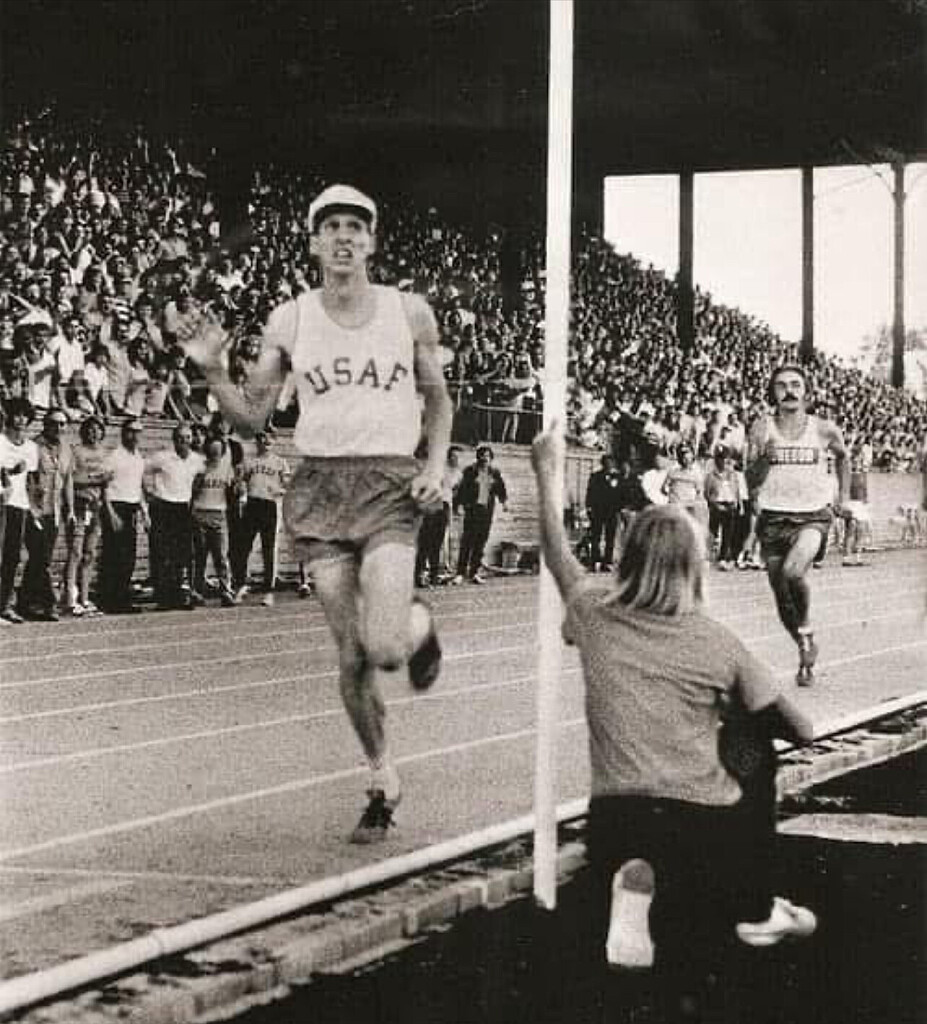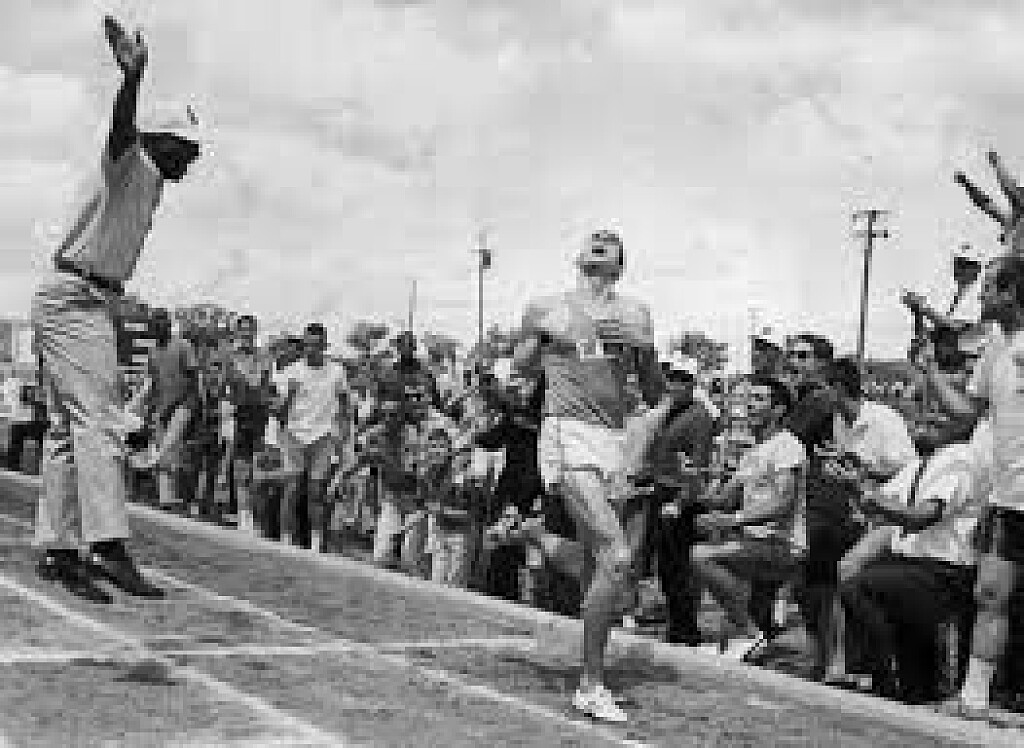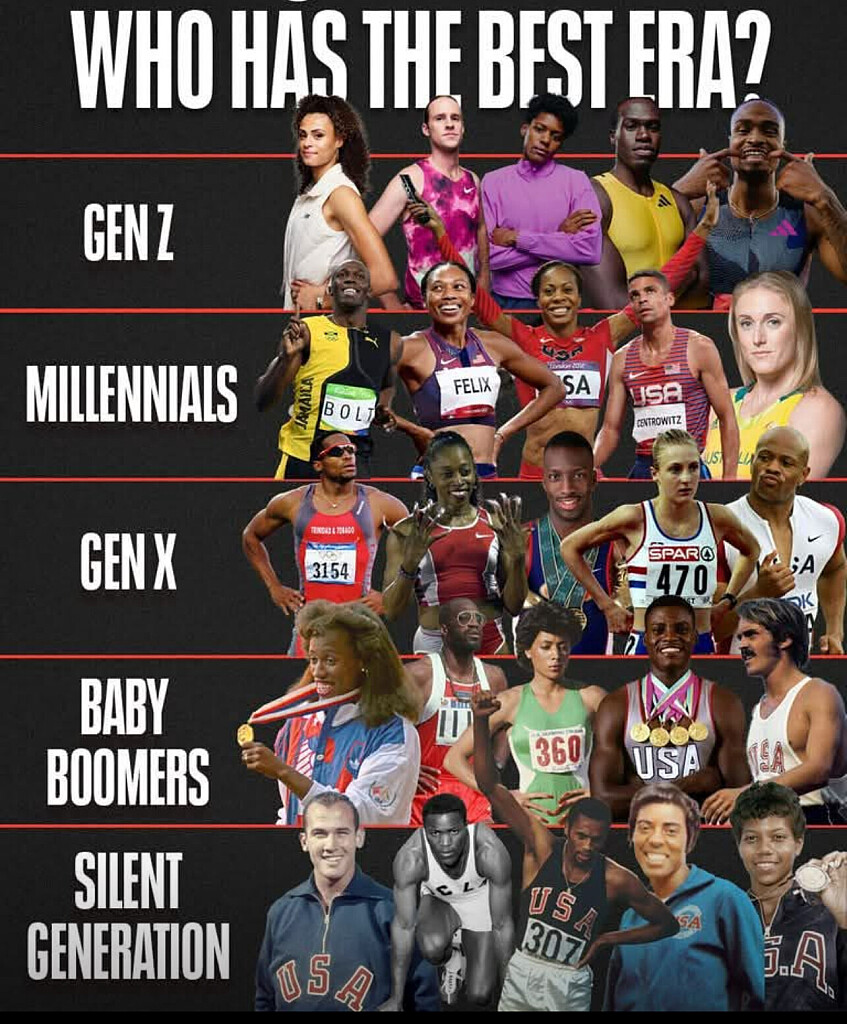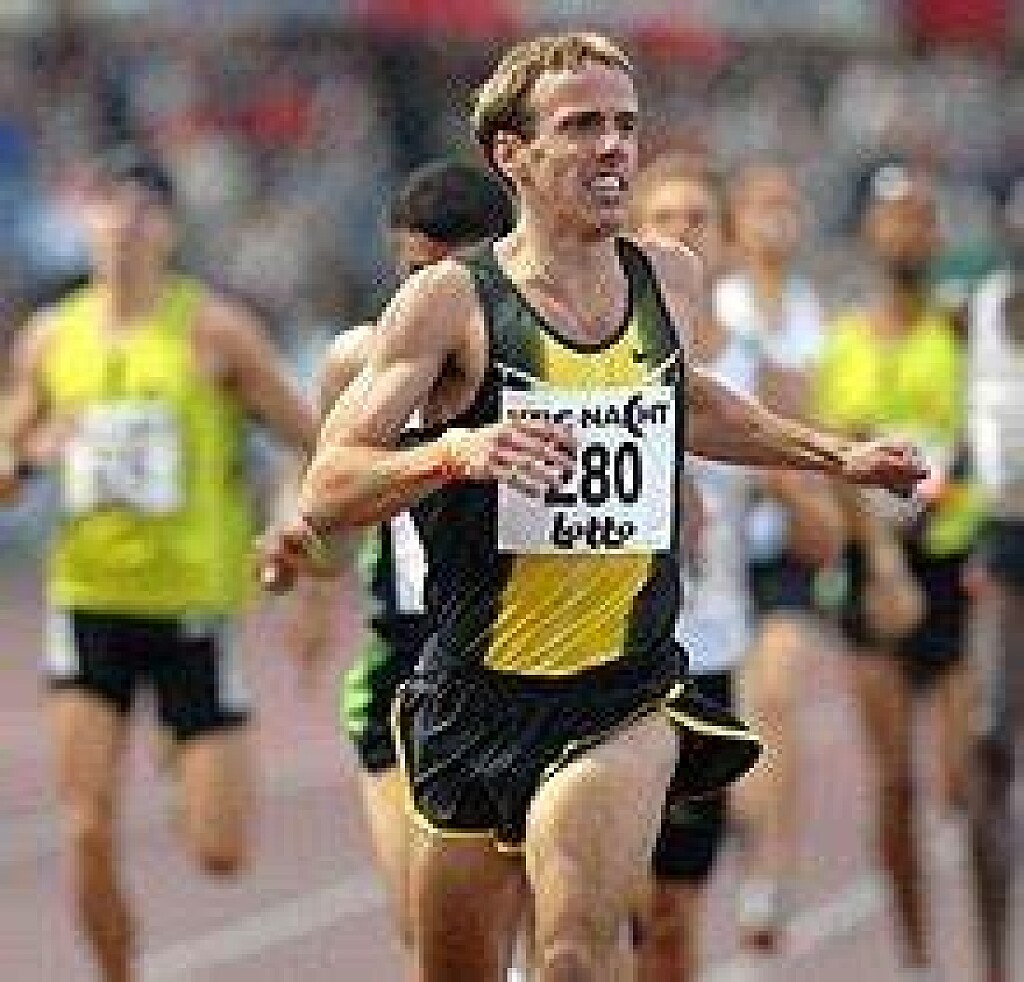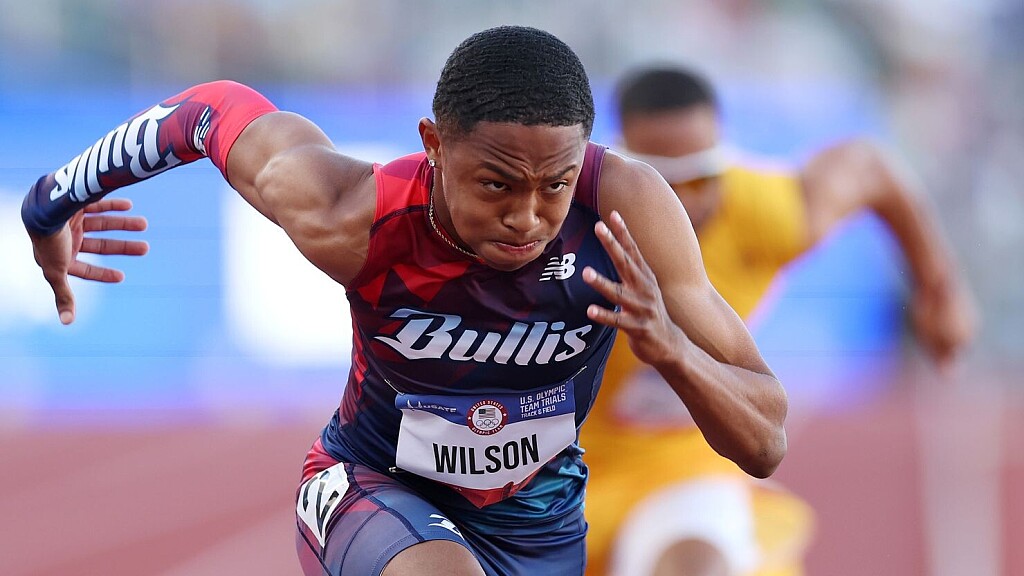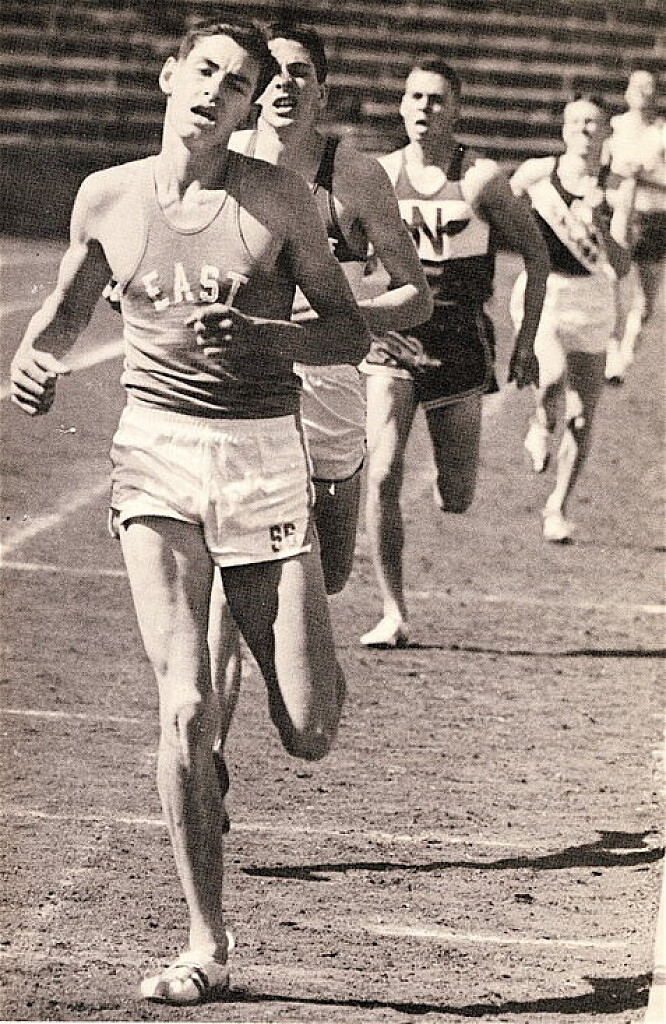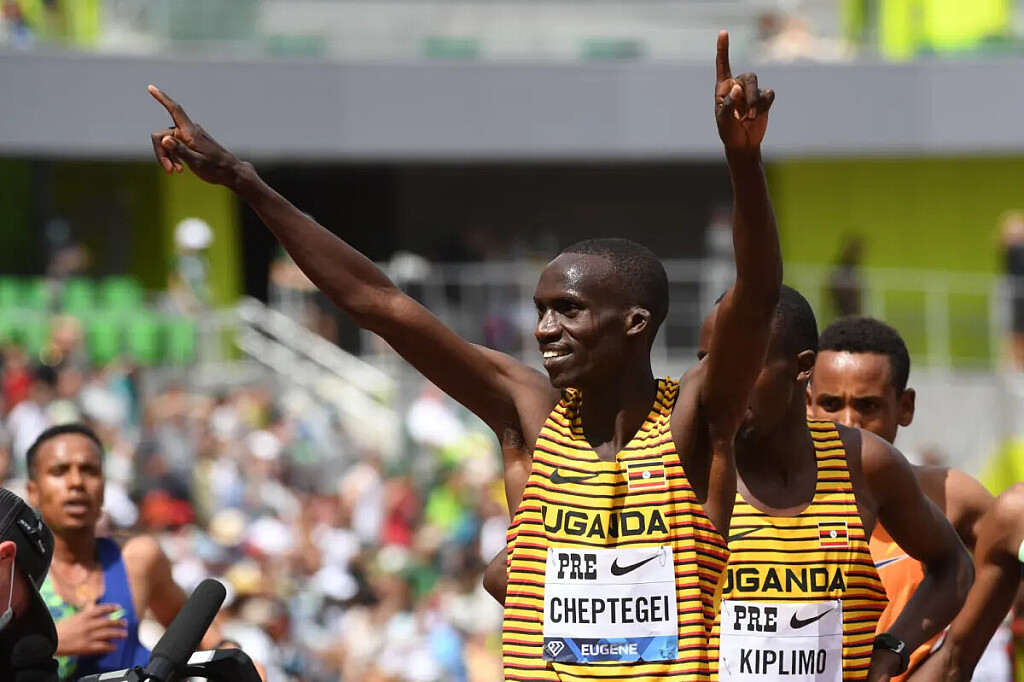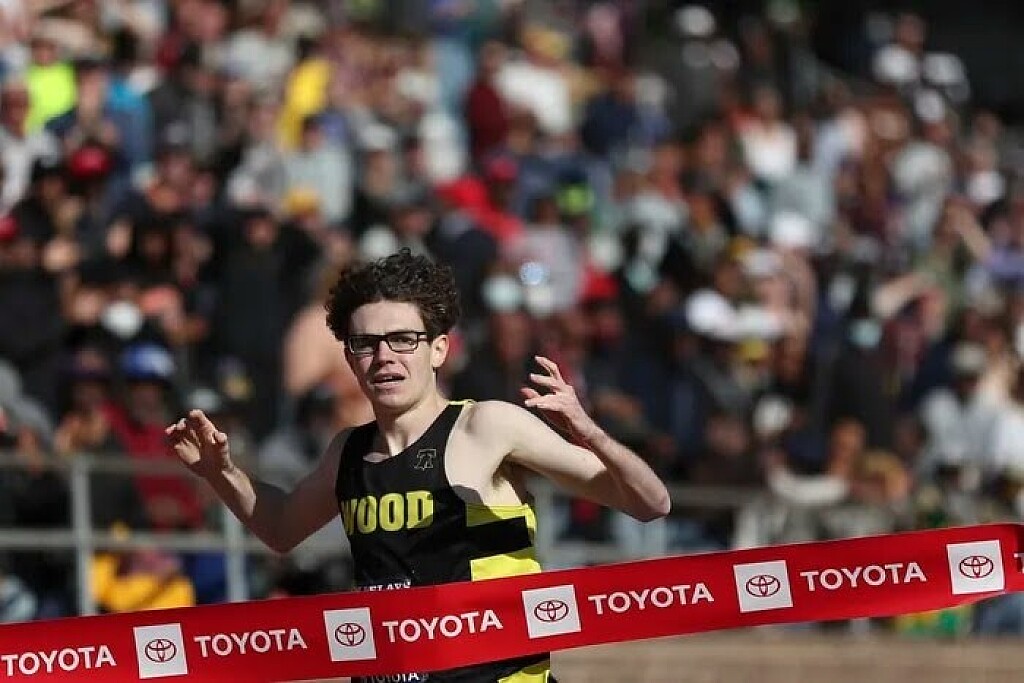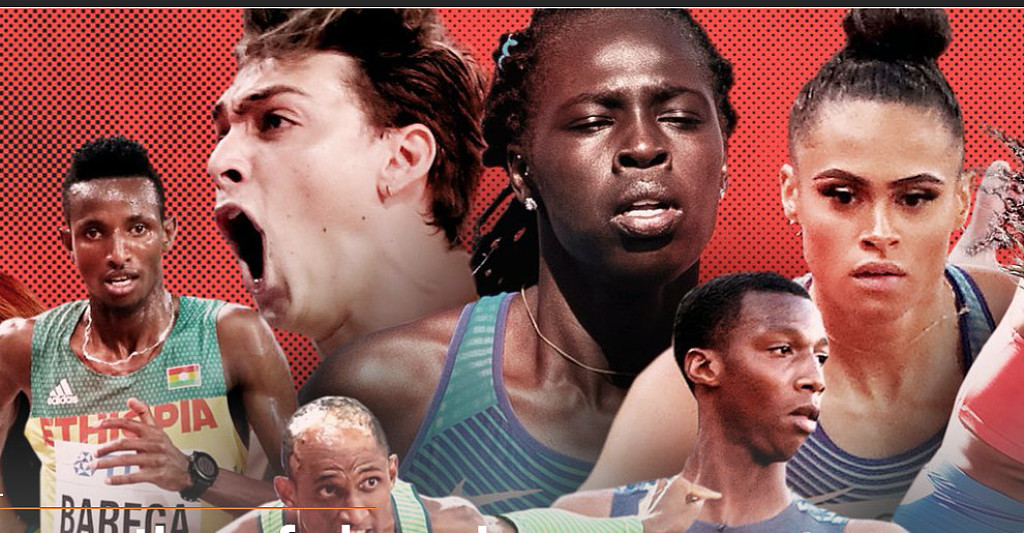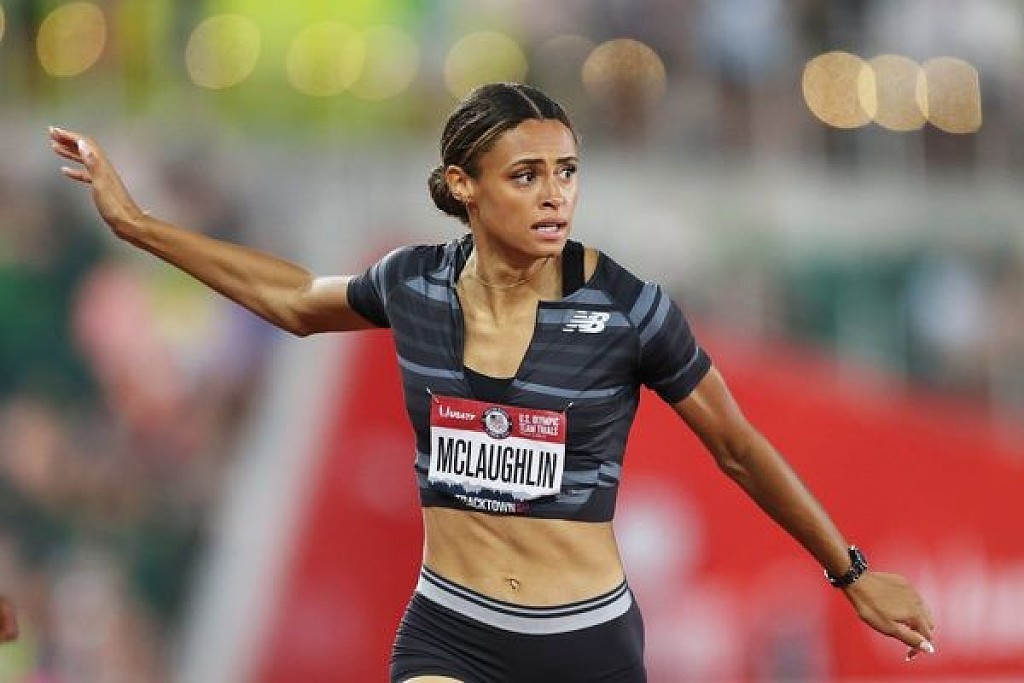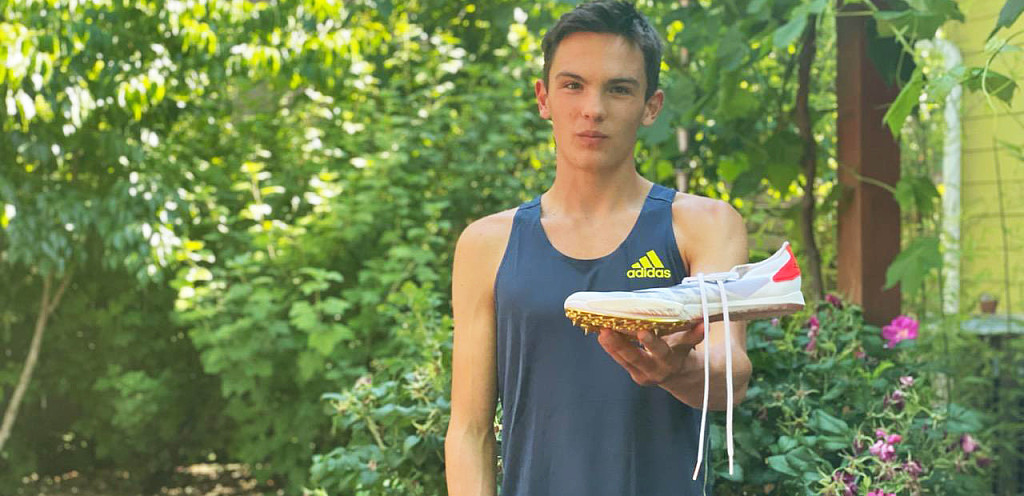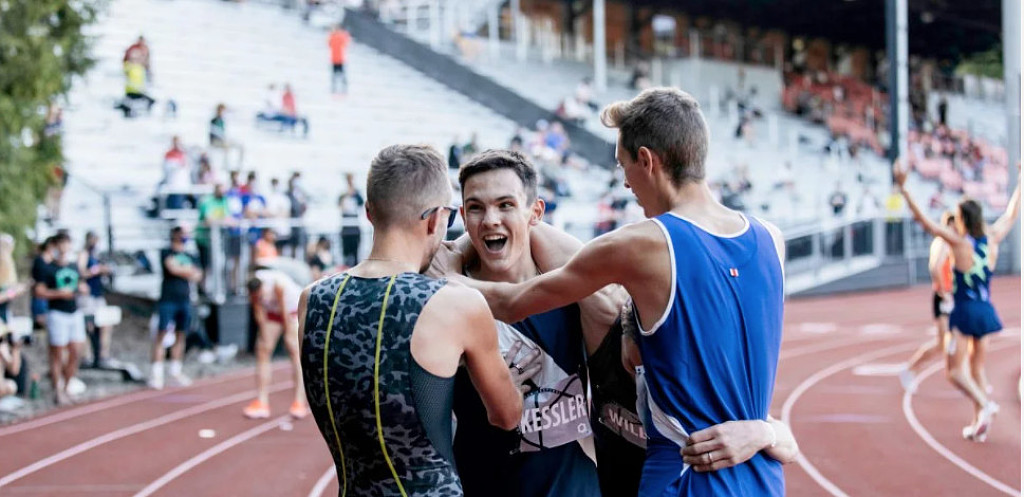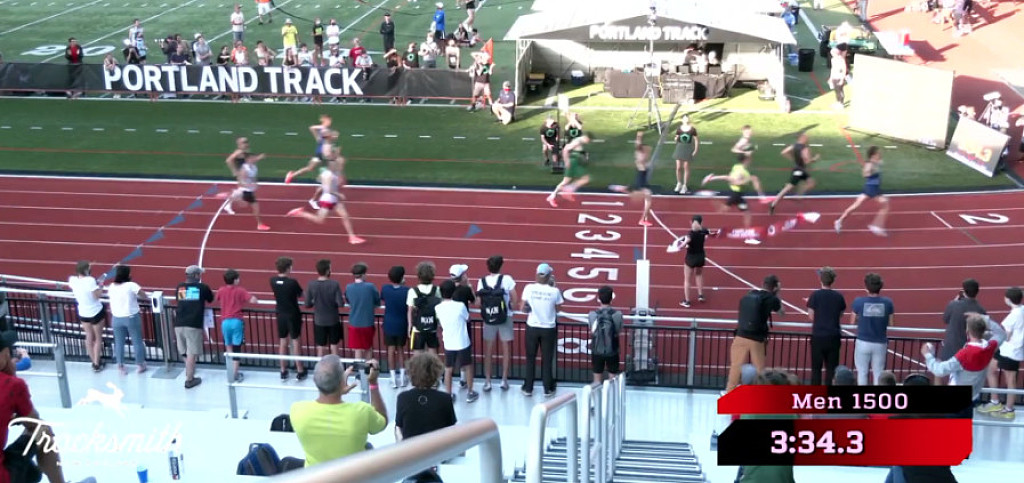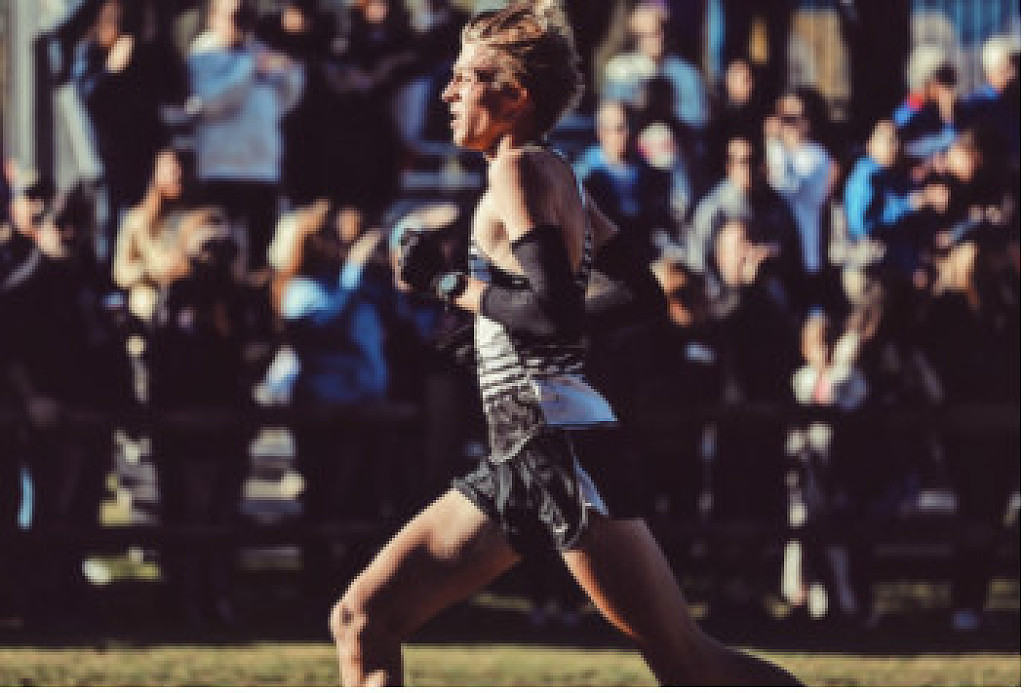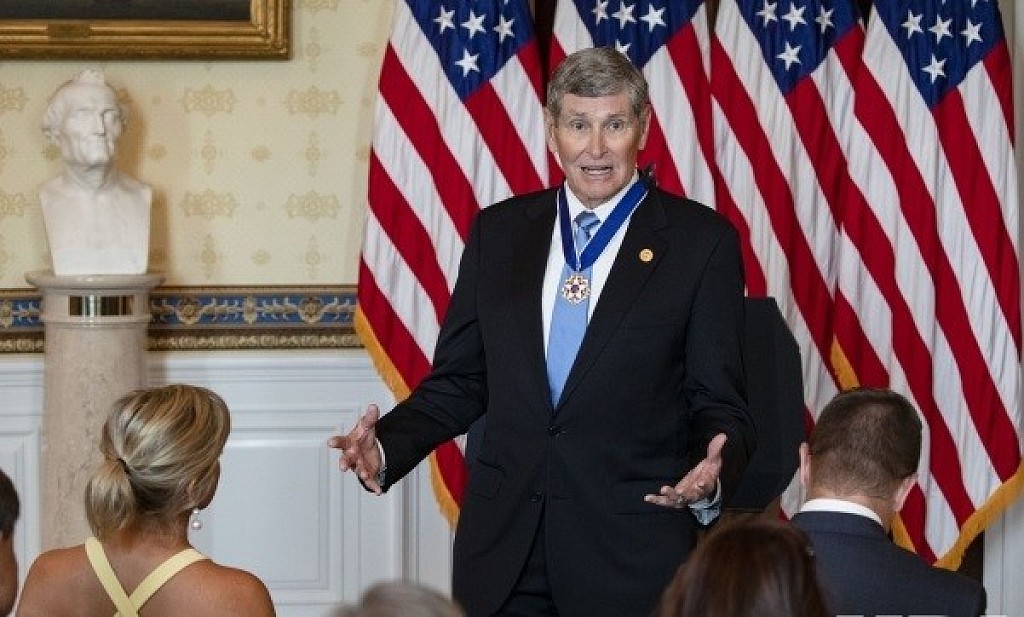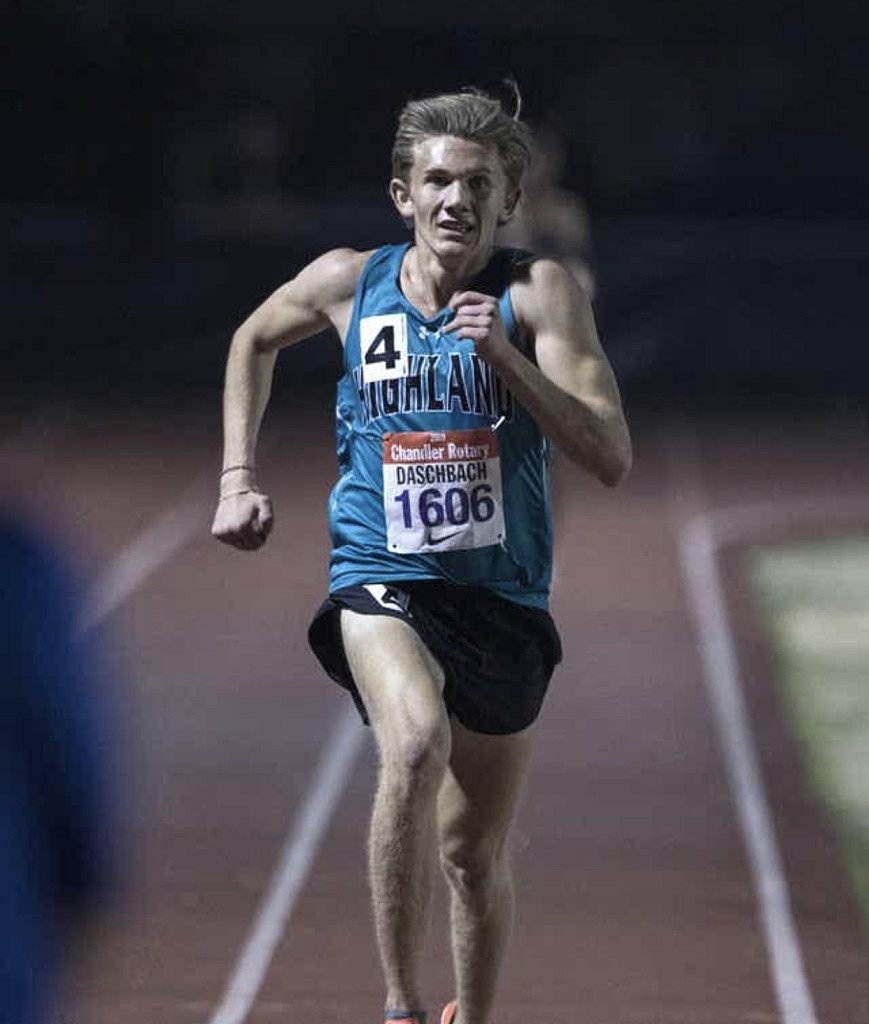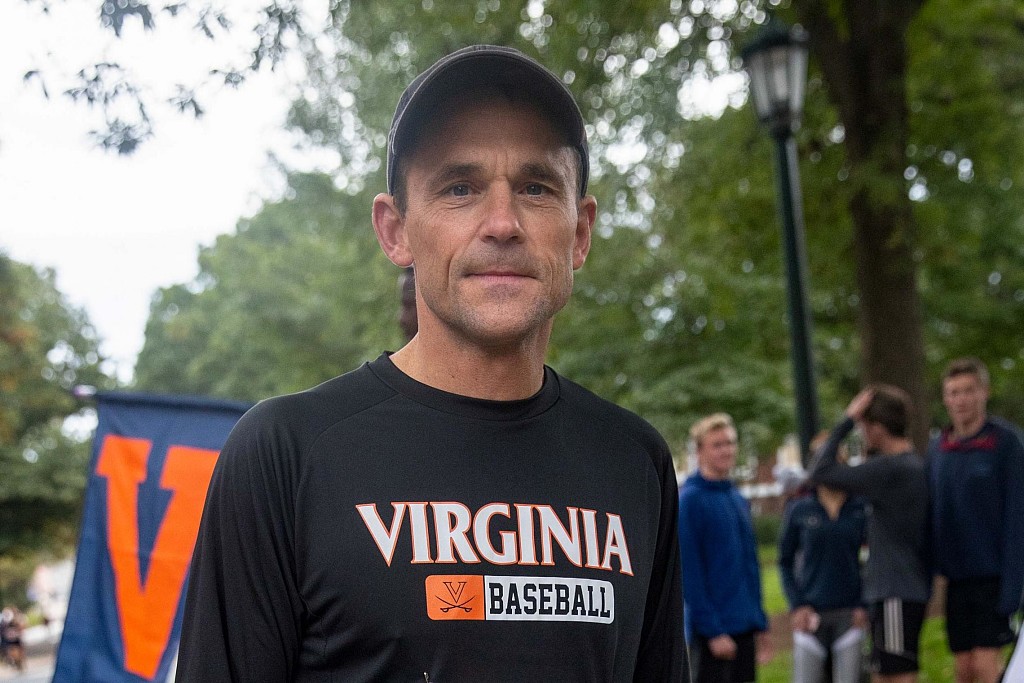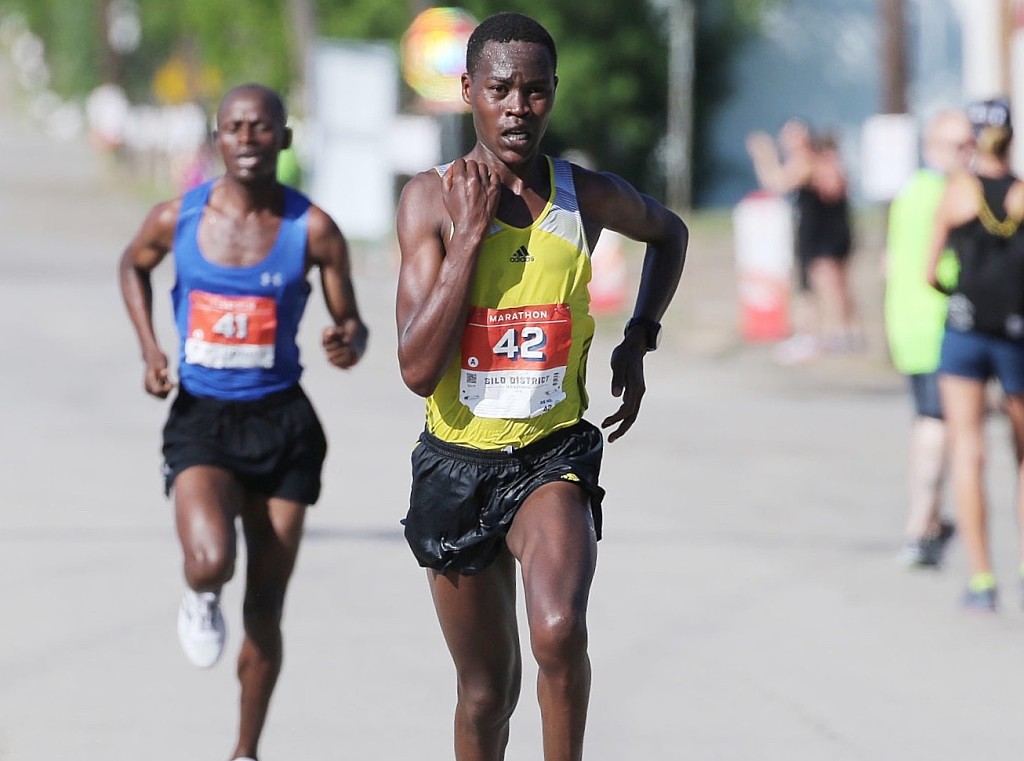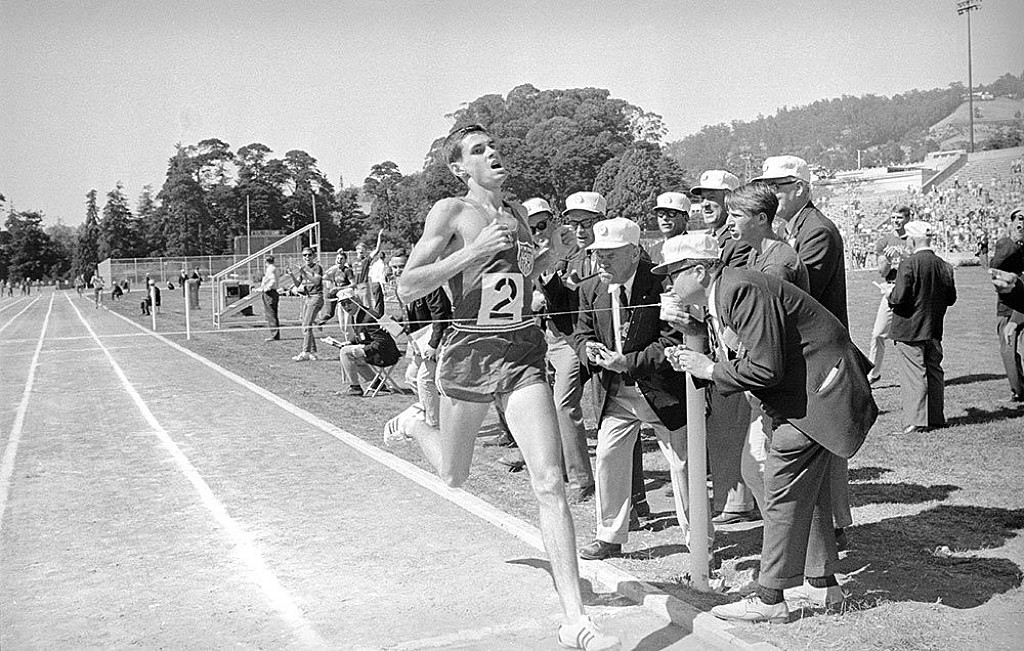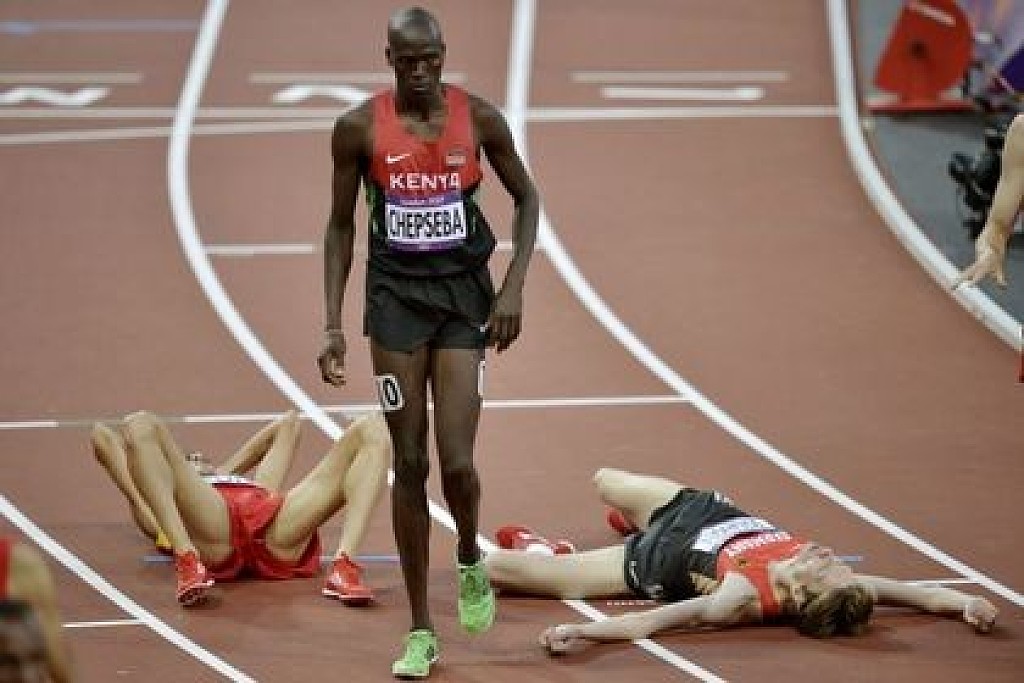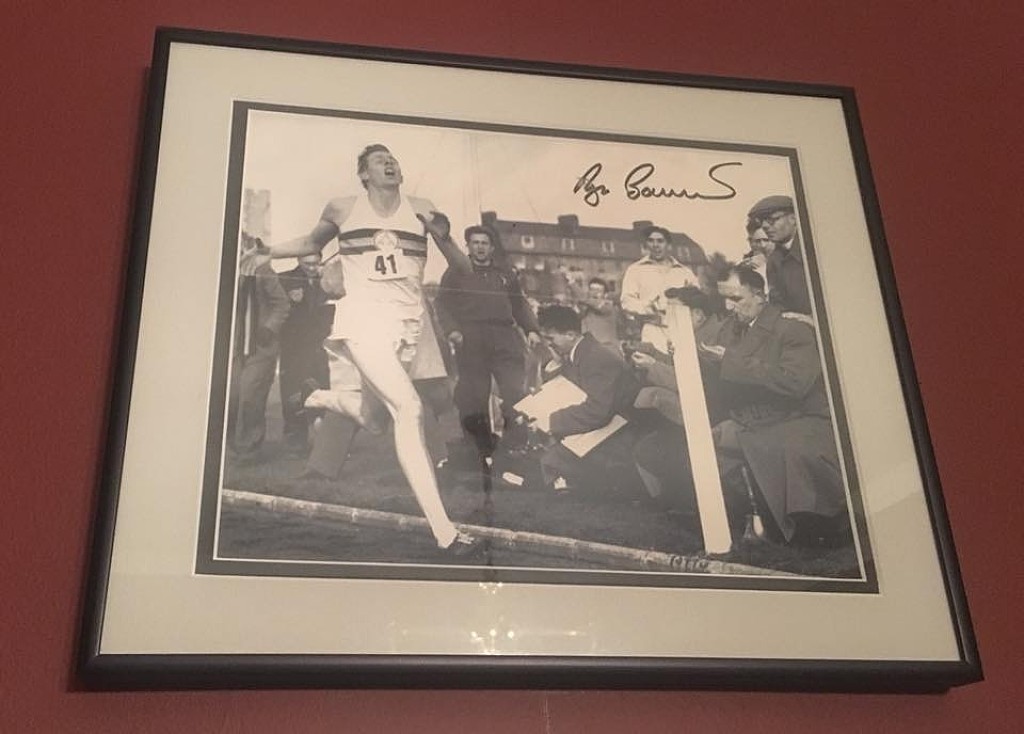Running News Daily
Running News Daily is edited by Bob Anderson. Send your news items to bob@mybestruns.com Advertising opportunities available. Train the Kenyan Way at KATA Kenya and Portugal owned and operated by Bob Anderson. Be sure to catch our movie A Long Run the movie KATA Running Camps and KATA Potato Farms - 31 now open in Kenya! https://kata.ke/
Index to Daily Posts · Sign Up For Updates · Run The World Feed
Articles tagged #Jim Ryun
Today's Running News
Eric Giacoletto: The Curator Preserving the Soul of Track and Field
In the fast-moving world of social media, few people are doing more to preserve the rich history of athletics than Eric Giacoletto. From his home in Albertville, France, Eric has become one of the most passionate archivists of the sport—sharing rare photos, insightful commentary, and forgotten moments that continue to inspire athletes and fans across the globe.
Though not a former elite runner himself, Eric’s knowledge runs deep, and his posts serve as daily reminders of what makes our sport timeless. He documents both legends and lesser-known heroes, giving context, names, and reverence to each moment he shares. His work has captured the attention of many—including My Best Runs founder Bob Anderson.
“What Eric is doing is important,” says Bob. “He’s preserving history—moments and athletes that might otherwise be forgotten. His posts are reminders of the beauty, pain, and glory of running.”
Just this past week, Eric posted dozens of compelling images from the golden eras of track and field. From that treasure trove, Bob Anderson selected eight photos he found particularly inspiring. Each tells a story—of courage, character, and the timeless spirit of competition.
Here are the eight photos Bob selected from Eric’s posts this past week:
Photo 1
Jim Ryun and Peter Snell – A Finish for the Ages
Two legends of the mile—Jim Ryun of Wichita and New Zealand’s Peter Snell—captured in one of the most dramatic finishes in middle-distance history. Ryun’s expression of anguish and Snell’s graceful stride speak volumes about what it takes to be world-class. An image that defines grit, shared by Eric earlier this week.
Photo 2
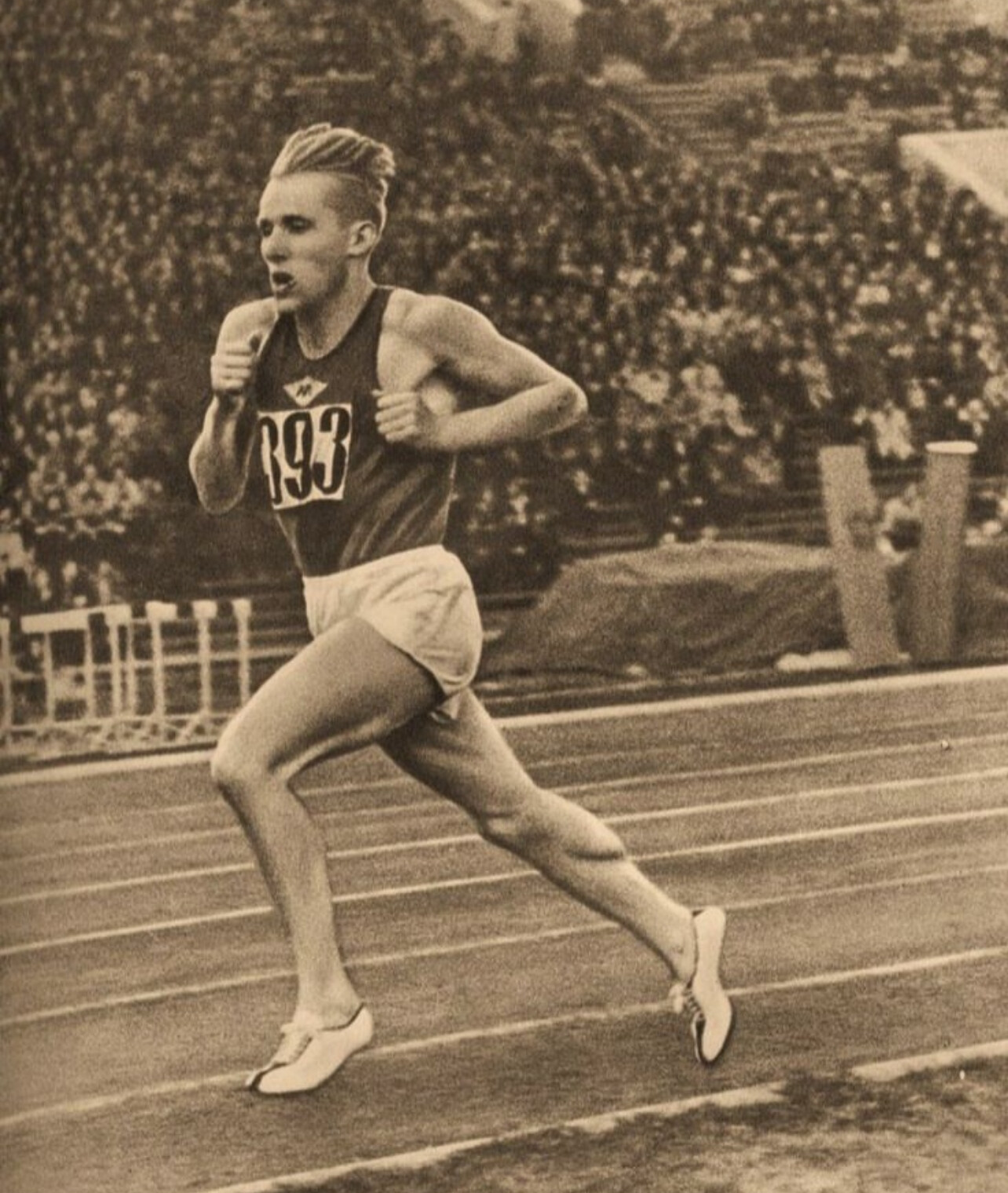
Vladimir Kuts – Soviet Powerhouse in Full Flight
Sprinting down the track with trademark aggression, Vladimir Kuts dominated the 1956 Olympics in Melbourne, winning both the 5,000m and 10,000m. Eric’s photo selection highlights Kuts’ unmistakable form and ferocity—a reminder of Eastern Bloc distance dominance during the Cold War era.
Photo 3
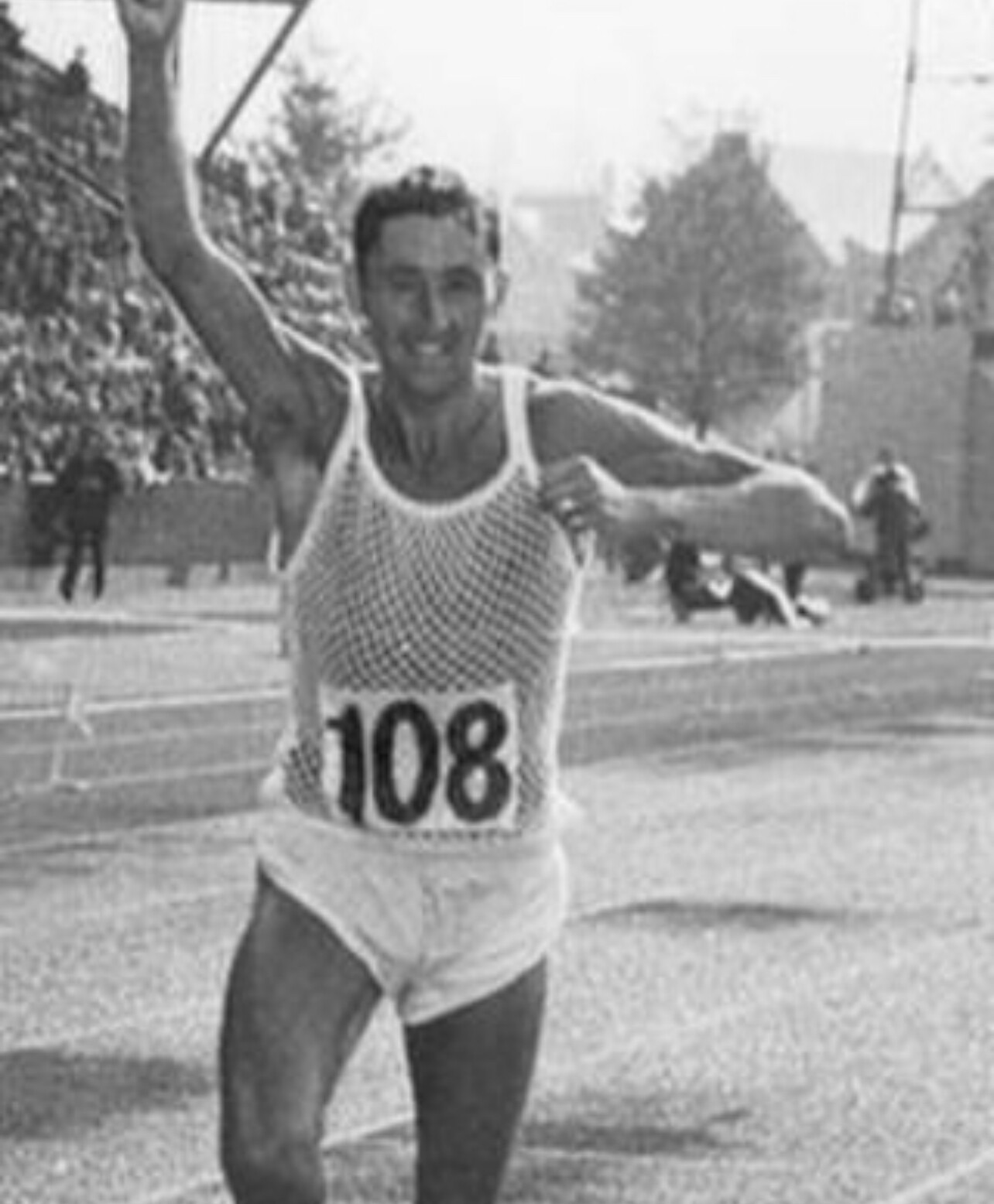
Ron Hill – 1970 Commonwealth Games, Edinburgh
Ron Hill, the pioneering English marathoner, crosses the line in his signature mesh singlet. By 2014, he had logged 159,106 lifetime miles—running at least one mile every day for 50 years. A legendary streak by a man who redefined commitment to the sport.
Photo 4
Steve Prefontaine in His Element
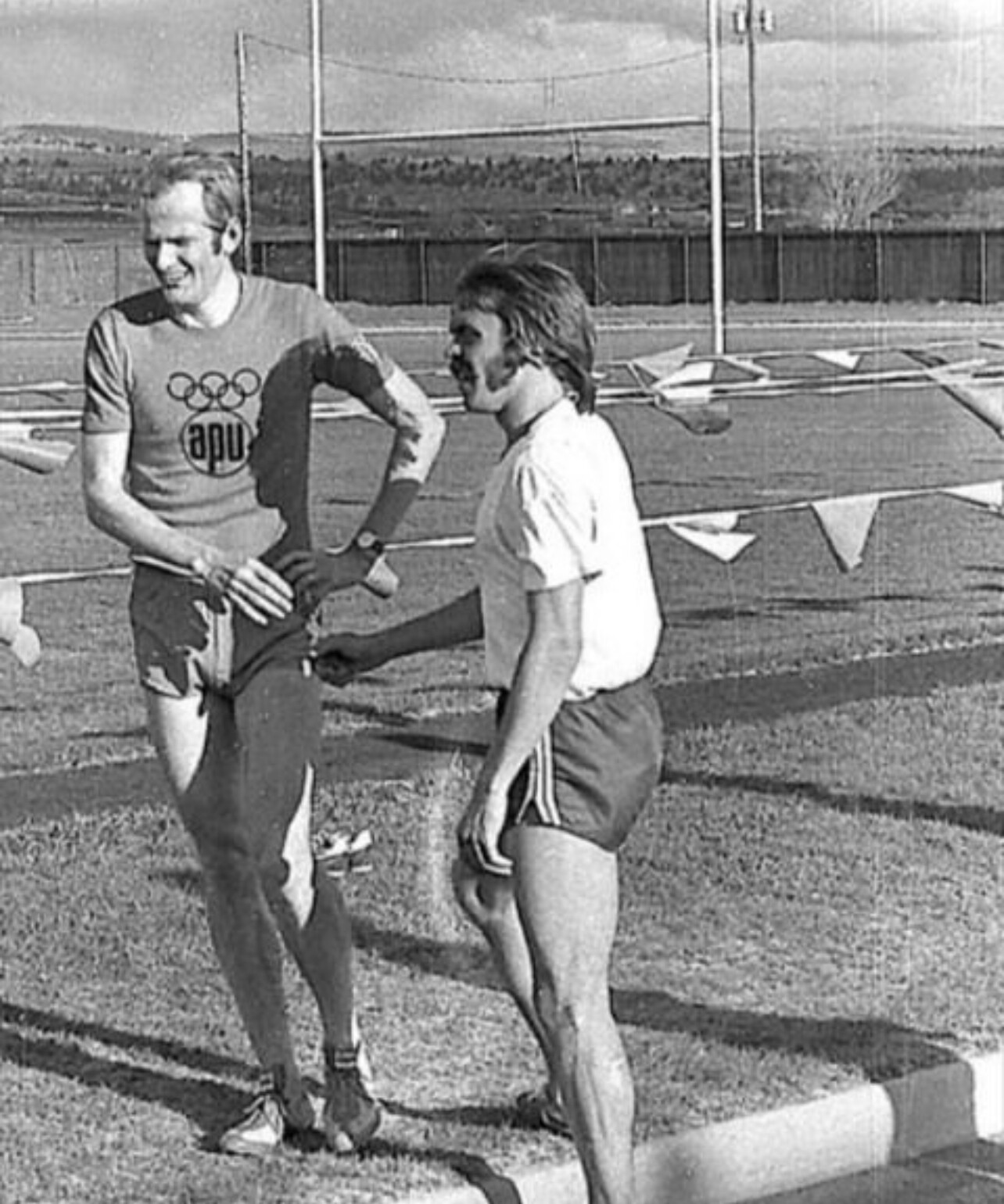
A candid photo of “Pre” during a training session, captured in conversation and camaraderie. Prefontaine’s fearless front-running style and outspoken personality made him a symbol of competitive fire. This relaxed moment shows the human side of a distance icon.
Photo 5
Herb Elliott – Training on the Dunes of Portsea

A powerful shot of Australian great Herb Elliott charging barefoot up the coastal sand dunes, guided by coach Percy Cerutty’s naturalist philosophy. Elliott never lost a 1500m or mile race in his career, and this photo shows the raw work behind that undefeated record.
Photo 6
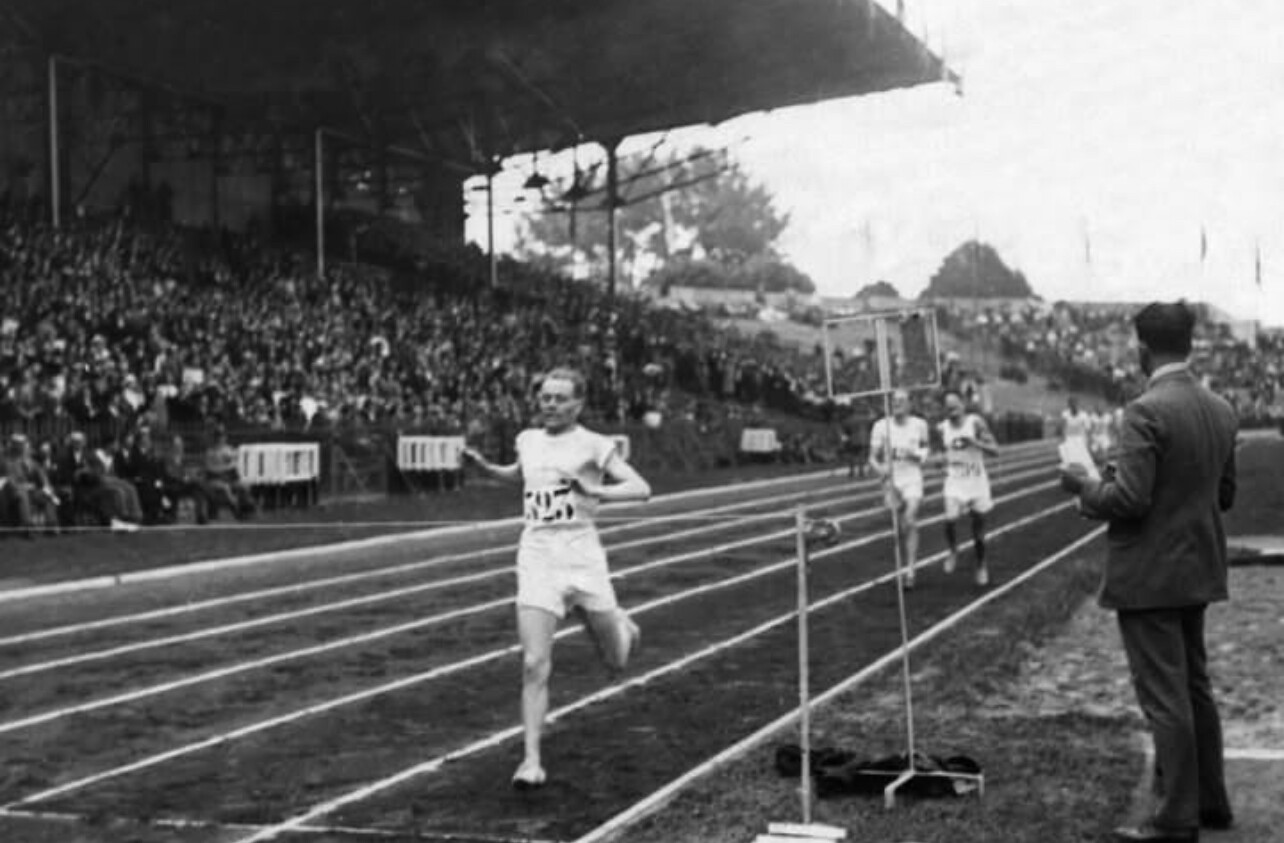
Paavo Nurmi – Double Gold in One Afternoon
Paris, July 10, 1924: Paavo Nurmi wins the 1500m, then returns just hours later to take gold again in the 5000m. This photo shows him well ahead of the field, delivering one of the most jaw-dropping performances in Olympic distance running history.
Photo 7
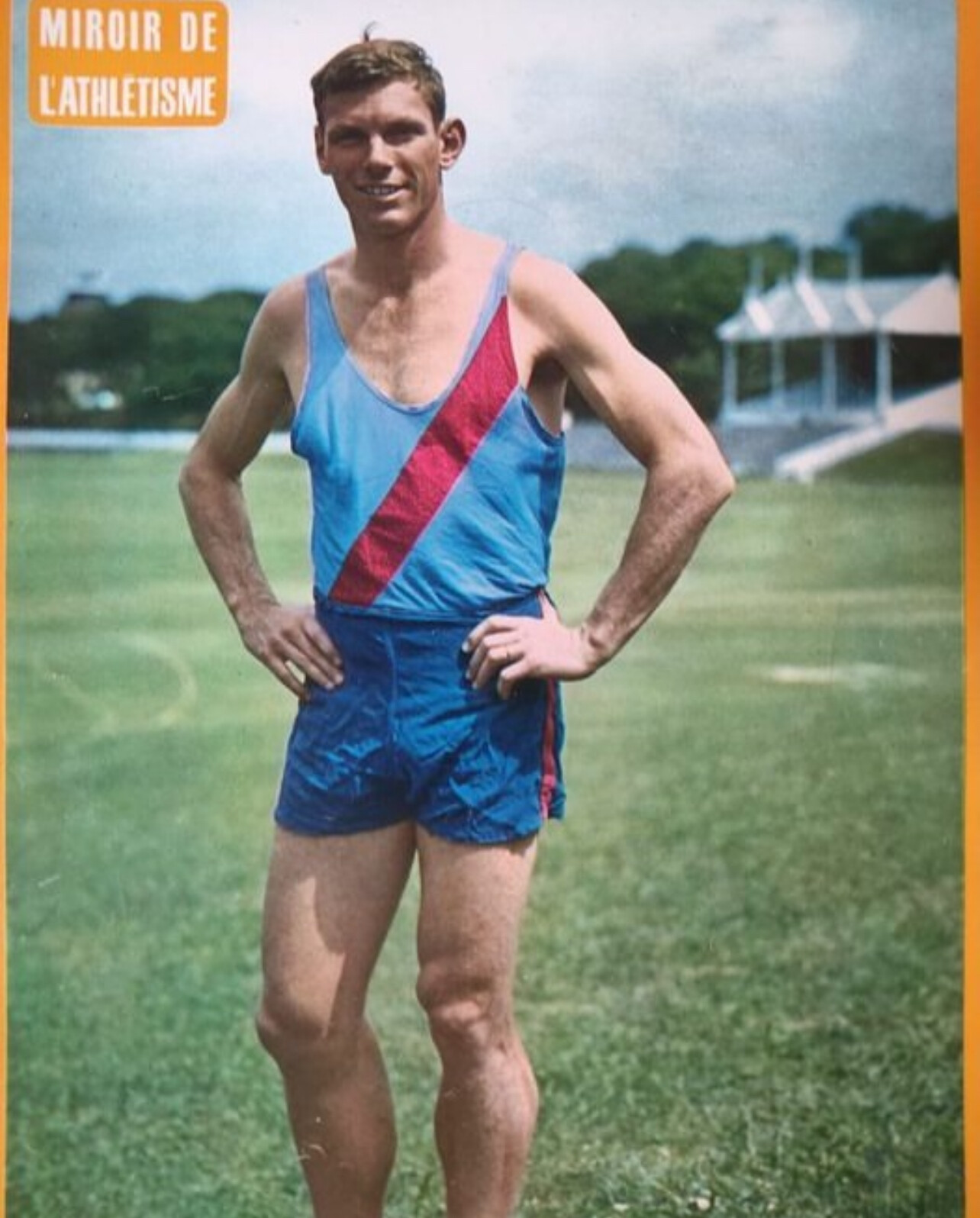
Peter Snell – Power and Poise in Color
A rare color image of New Zealand’s Peter Snell, one of the greatest middle-distance runners of all time. Winner of three Olympic gold medals, Snell combined strength with speed in a way few ever have. Eric’s post brings his iconic stature to life in full color.
Photo 8
Bill Rodgers – Boston Breakaway, 1975
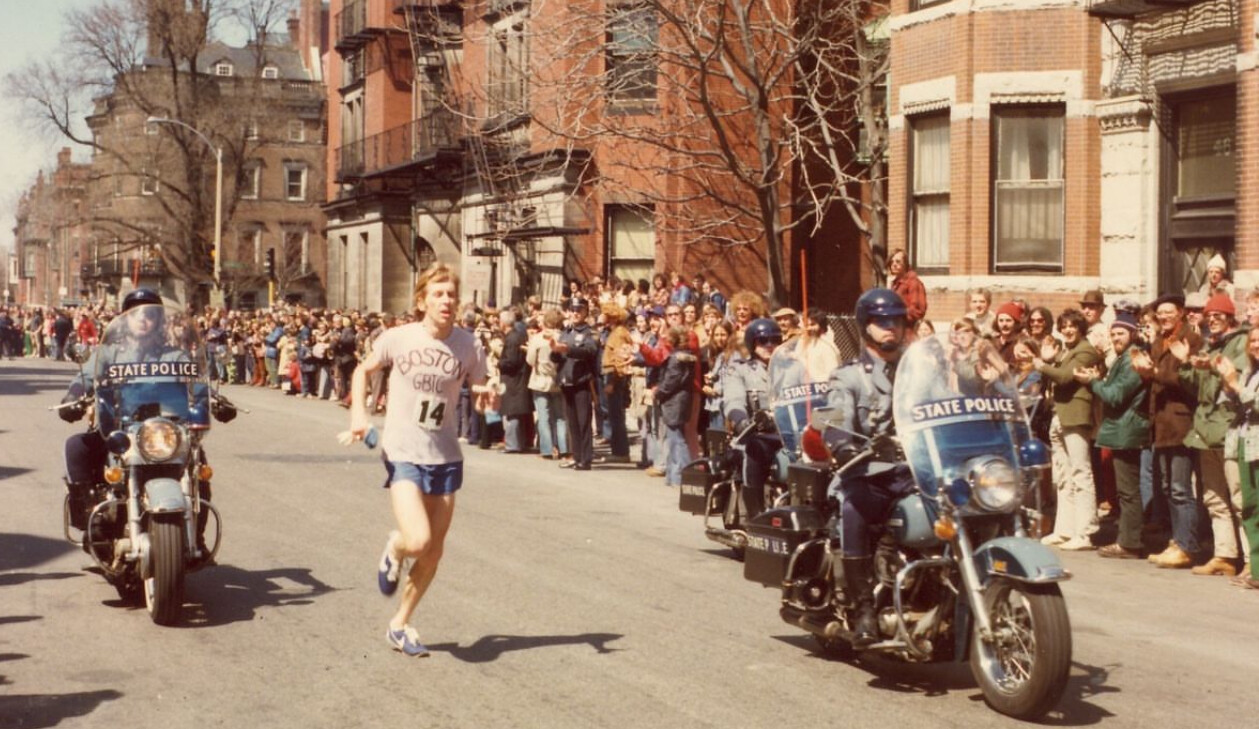
Captured mid-stride during his victory at the 1975 Boston Marathon, Bill Rodgers pulls away under the escort of state police motorcycles. His win that year—2:09:55—was part of a dominant streak that made him a U.S. marathon legend. A city, and a sport, in full celebration.
Honoring the Archivist
Eric’s posts on Facebook and Instagram (@ericgiacoletto) continue to spark meaningful conversations among athletes, historians, and lifelong fans. Whether he’s unearthing a forgotten race photo or celebrating an athlete’s legacy, Eric is doing more than documenting—he’s inspiring.
If you enjoyed this feature, and with Eric’s permission, we’d love to post more regularly here at My Best Runs. Let us know what you think—we’re always looking to spotlight the people and moments that keep the spirit of our sport alive.
by Boris Baron and Bob Anderson
Login to leave a comment
Pre vs. Wottle: The Day Eugene Witnessed a Mile Duel for the Ages
Inspired by a post from Eric Giacoletto
On June 20, 1973, Hayward Field in Eugene, Oregon, hosted one of the most legendary mile showdowns in U.S. track history—a dramatic match race between Steve Prefontaine and Dave Wottlethat captivated a sold-out crowd and etched itself into the sport’s folklore.

The event was the Hayward Restoration Meet, a grassroots effort to raise funds to rebuild the stadium’s deteriorating wooden grandstands, which had been condemned by the Eugene Fire Department. Prefontaine, ever the promoter and competitor, helped organize a marquee matchup to fill the stands and elevate the cause.
Pre invited Dave Wottle, who was then riding high after winning gold in the 800 meters at the 1972 Munich Olympics, for a one-mile race that would bring elite energy to Eugene. Wottle accepted the challenge.
According to Giacoletto’s telling, Prefontaine told Wottle:
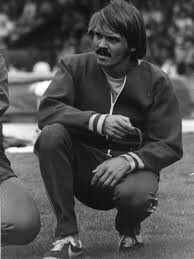
“We’ll go after the world record in the mile, and I’ll set the pace. I’ll bring you through in 2:56, and then it’s each man for himself on the last lap.”
On race day, true to his word, Pre hit the 880-yard mark in 1:56.8 and the three-quarter mile in 2:56.0—perfect pacing for a potential world record.
But with just over 220 yards remaining, Wottle unleashed his signature long sprint. In front of a roaring Hayward crowd, Wottle surged past Pre to win in 3:53.3, the third-fastest mile in history at the time, behind only Jim Ryun’s 3:51.1 world record (1967) and Marty Liquori’s 3:52.2 (1971).
Prefontaine finished second in 3:54.7, which tied him for ninth on the all-time list. John Hartnett of Villanova and Ireland kicked hard to take third in 3:54.8, placing 11th all-time.
Why This Race Still Resonates
• It was Wottle’s career-best mile, proving his range extended well beyond 800 meters.
• It showed Prefontaine’s commitment to elevating the sport, even at the risk of losing.
• It became a key chapter in Hayward Field’s history and Oregon’s running identity.
As Eric Giacoletto beautifully summarized, this was “an epic day in track nerd history”—a pure demonstration of guts, pacing, and competitive fire that helped shape American distance running.
by Boris Baron
Login to leave a comment
Jim Ryun Still Inspires Generations One Mile at a Time
Few names in track and field history carry the weight of Jim Ryun. A high school prodigy, world record holder, Olympian, and public servant, Ryun’s legacy continues to inspire runners around the world—even decades after his final lap.
On May 15, 1965, Ryun delivered what many consider the greatest high school mile performance of all time. Running on a dirt (or cinder) track and competing exclusively against high school runners, the 18-year-old Ryun clocked an astonishing 3:58.3, marking his second career sub-4-minute mile. The moment was electric, captured in a now-iconic photo of Ryun breaking the tape, roaring with emotion as spectators leaned in, visibly aware they were witnessing history.

Special thanks to Gary Cohen for reminding us of this important anniversary and the lasting impact of that race. Sixty years later, it remains a symbol of youth, potential, and the power of belief.
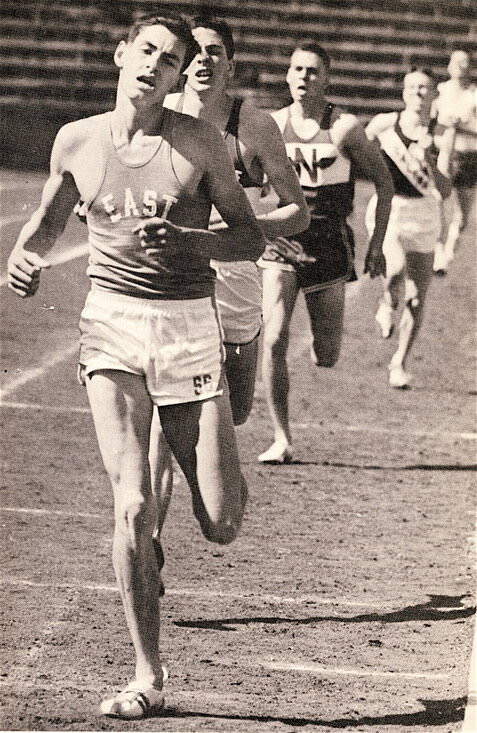
From Track to Capitol Hill
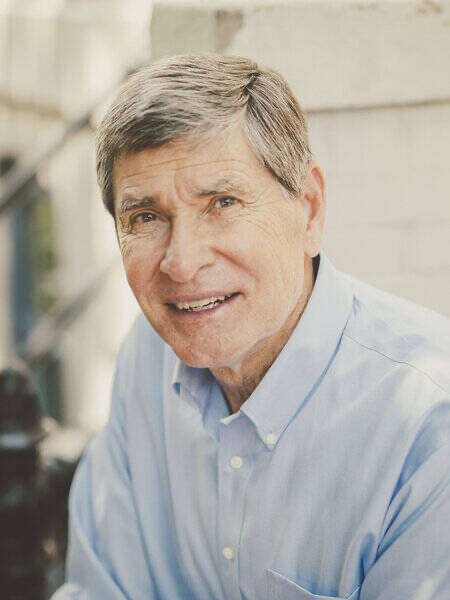
Jim Ryun went on to win a silver medal in the 1500 meters at the 1968 Olympics and set multiple world records—including the mile (3:51.1), 1500 meters (3:33.1), and 880 yards (2:16.2). After retiring from competitive running, he transitioned into public service, serving five terms in the U.S. House of Representatives for Kansas.
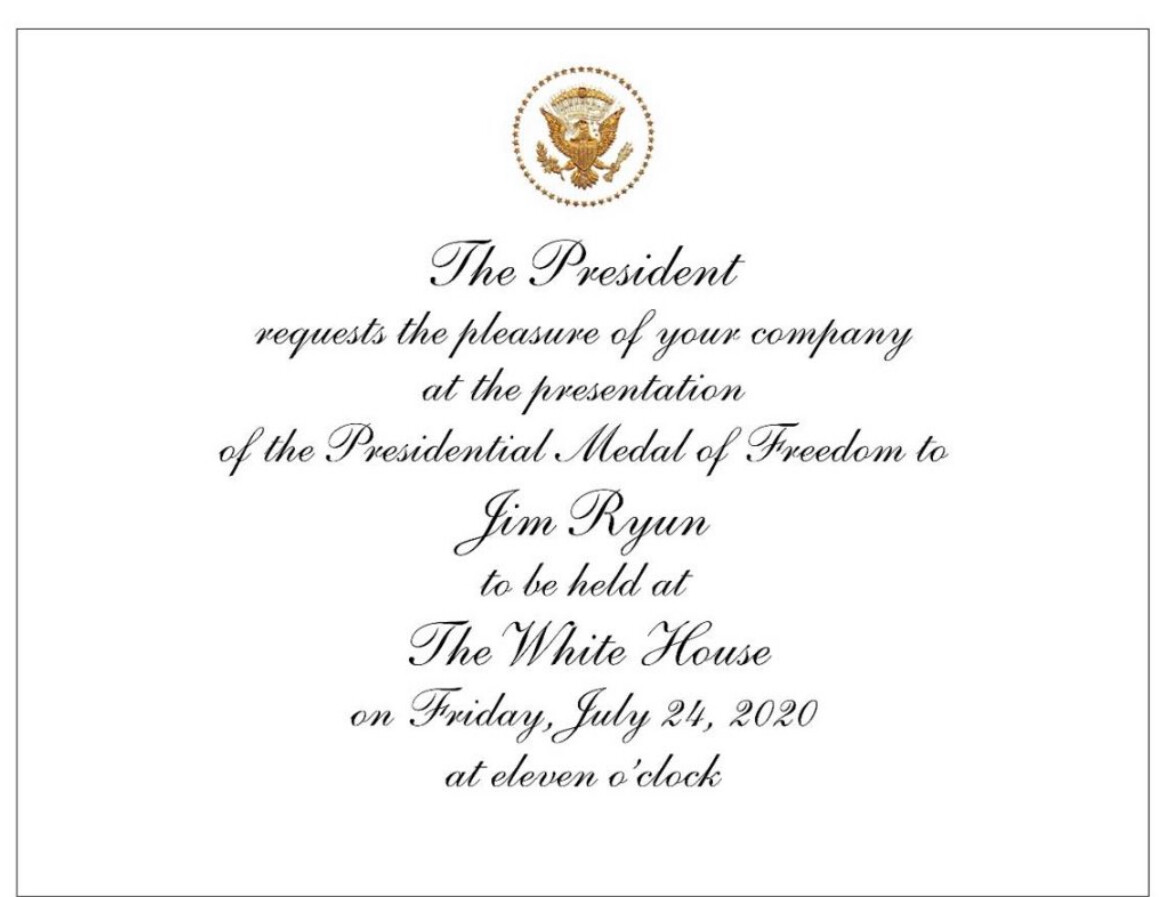
Still Leading by Example
Today, Ryun remains a prominent voice in the running community. Through The Jim Ryun Running Camps, he mentors young athletes across the country—instilling not just proper training techniques, but also values like leadership, discipline, and integrity. He also travels the nation as a motivational speaker, drawing from his experience as both an athlete and a public servant.
In 2020, Ryun was awarded the Presidential Medal of Freedom, the highest civilian honor in the United States—a testament to his enduring impact on sports and society.
A Legacy That Endures
Jim Ryun’s 3:58.3 on May 15, 1965, wasn’t just a race—it was a cultural moment. A teenager, defying the odds, rewriting expectations, and doing it with humility and heart.
And six decades later, he’s still showing us what’s possible.
by Boris Baron
Login to leave a comment
Jim and I was in high school at the same time in Kansas. I also knew his coach, Bob Timmons. His coaching style motivated my high school coach to follow in his footsteps. Our toughest workout we did was 48x440. We did win our regional cross country meet and placed second at state. So it worked but it was a monster of a workout. We averaged just under 70 seconds each. - Bob Anderson 5/15 9:50 am |
Who Had the Best Era in Track & Field? A Generational Showdown
Track and field has long been the stage for some of the most electrifying athletic performances in history. Each generation has produced legends who have redefined what is possible in sprinting, distance running, and field events. But which era stands above the rest?
From the Silent Generation pioneers to the Gen Z record-breakers, every period has contributed to the evolution of the sport. Let’s break down each era’s greatest stars and their lasting impact on track and field.
Gen Z (Born 1997 - 2012): The Future of Track & Field
The newest generation of elite athletes is already making waves on the world stage. With the benefit of cutting-edge training, nutrition, and recovery techniques, these young stars are smashing records at a rapid pace.
Notable Sprinters & Field Athletes:
• Sydney McLaughlin-Levrone (USA) – 400m hurdles world record holder and Olympic champion
• Mondo Duplantis (Sweden) – Pole vault world record holder
• Erriyon Knighton (USA) – One of the fastest teenagers ever in the 200m
Notable Distance Runners:
• Jakob Ingebrigtsen (Norway) – Olympic 1500m champion, European mile record holder
• Joshua Cheptegei (Uganda) – 5000m and 10,000m world record holder
• Jacob Kiplimo (Uganda) – Half marathon world record holder (57:31)
• Gudaf Tsegay (Ethiopia) – World champion in the 1500m, dominant in middle distances
Gen Z athletes are not only breaking records but also shaping the future of the sport through their influence on social media and global visibility. With their combination of speed, endurance, and access to modern sports science, they may soon surpass all who came before them.
Defining Traits: Explosive, record-breaking, tech-savvy
Millennials (Born 1981 - 1996): The Superstars of the Modern Era
No discussion of dominant track and field generations is complete without mentioning Usain Bolt. The Jamaican sprinting legend captured the world’s attention with his charisma and untouchable world records.
Notable Sprinters:
• Usain Bolt (Jamaica) – Fastest man in history (100m: 9.58, 200m: 19.19)
• Allyson Felix (USA) – Most decorated female Olympian in track history
• Shelly-Ann Fraser-Pryce (Jamaica) – One of the most dominant sprinters of all time
Notable Distance Runners:
• Eliud Kipchoge (Kenya) – The greatest marathoner of all time, first to break two hours in a marathon
• Mo Farah (UK) – Dominated the 5000m and 10,000m at two Olympic Games
• Genzebe Dibaba (Ethiopia) – 1500m world record holder
• Ruth Chepngetich (Kenya) – First woman to break the 2:10 barrier in the marathon, setting a world record of 2:09:56 at the 2024 Chicago Marathon
Millennials excelled across all track and field disciplines. They ushered in an era of professional distance running dominance, with African runners setting standards in middle and long distances. Meanwhile, Kipchoge’s sub-2-hour marathon attempt was a historic milestone in human endurance.
Defining Traits: Charismatic, dominant, endurance revolutionaries
Gen X (Born 1965 - 1980): The Tough and Versatile Competitors
Gen X athletes were the bridge between the amateur days of track and the fully professional era. They pushed the sport forward with fierce rivalries and new records, while also seeing the globalization of track and field.
Notable Sprinters:
• Maurice Greene (USA) – Former world record holder in the 100m (9.79)
• Marion Jones (USA) – One of the most dominant sprinters of the late ‘90s
Notable Distance Runners:
• Haile Gebrselassie (Ethiopia) – Olympic and world champion, former marathon world record holder
• Paul Tergat (Kenya) – Pioneered marathon running dominance for Kenya
• Tegla Loroupe (Kenya) – First African woman to hold the marathon world record
This era marked a golden age for distance running, with Gebrselassie and Tergat setting the stage for the marathon revolution that would come in the next generation. With increased sponsorships, the road racing circuit became more competitive, and Kenyan and Ethiopian dominance solidified.
Defining Traits: Tough, globalized, long-distance pioneers
Baby Boomers (Born 1946 - 1964): The Golden Age of Track & Field
The Baby Boomers took track and field into the modern Olympic era, producing some of the most iconic figures in the sport’s history.
Notable Sprinters:
• Carl Lewis (USA) – Nine-time Olympic gold medalist across sprints and long jump
• Florence Griffith-Joyner (USA) – 100m (10.49) and 200m (21.34) world record holder
Notable Distance Runners:
• Sebastian Coe (UK) – 800m and 1500m Olympic champion, middle-distance legend
• Steve Prefontaine (USA) – One of the most influential distance runners in history
• Miruts Yifter (Ethiopia) – 5000m and 10,000m Olympic champion
This era brought middle and long-distance running into the mainstream, with rivalries like Coe vs. Ovett and Prefontaine vs. the world captivating fans. The Baby Boomers were the first generation of professional-level training and saw athletes truly dedicated to their craft year-round.
Defining Traits: Bold, revolutionary, multi-talented
Silent Generation (Born 1928 - 1945): The Pioneers of Kenya’s Dominance
This generation laid the foundation for modern track and field, producing legends whose influence still resonates today.
Notable Distance Runners:
• Kip Keino (Kenya) – The pioneer of Kenya’s dominance in distance running, winning Olympic gold in the 1500m (1968) and 3000m steeplechase (1972)
• Emil Zátopek (Czechoslovakia) – Triple gold in 5000m, 10,000m, and marathon at the 1952 Helsinki Olympics
• Paavo Nurmi (Finland) – Nine-time Olympic gold medalist in long-distance events
Kip Keino’s triumph over Jim Ryun in the 1500m final at the 1968 Mexico City Olympics is considered one of the greatest upsets in Olympic history. Competing at high altitude, Keino used a fast early pace to break Ryun, ushering in an era of Kenyan middle-distance dominance that continues today.
Defining Traits: Groundbreaking, resilient, visionary
Which Generation Had the Greatest Impact?
Each generation of track and field athletes has contributed to the sport’s evolution in unique ways:
• Millennials brought global superstardom (Bolt, Felix, Fraser-Pryce, Kipchoge, Chepngetich)
• Gen X athletes were fierce competitors in a rapidly changing sport (Greene, Gebrselassie, Tergat)
• The Baby Boomers set records that still stand today (Carl Lewis, Flo Jo, Coe, Prefontaine)
• The Silent Generation laid the foundation for modern track and field (Owens, Zátopek, Kip Keino)
• Gen Z is already breaking records and shaping the future of the sport (McLaughlin-Levrone, Ingebrigtsen, Cheptegei)
While it’s hard to declare one era the best, one thing is certain: the sport of track and field continues to evolve, with each generation pushing the limits of human performance.
Which generation do you think is the greatest? Let us know in the comments!
by Boris Baron
Login to leave a comment
The Evolution of the High School Sub-4 Mile Club
On May 6, 1954, Roger Bannister made history by running the first sub-4-minute mile, clocking 3:59.4 in Oxford, England. His groundbreaking achievement redefined what was possible in middle-distance running, inspiring generations of athletes to chase the elusive mark.
For decades, breaking the 4-minute barrier remained an extraordinary feat, but in recent years, more high school runners in the United States have joined this exclusive club. As of February 2025, 23 American high school boys have accomplished this milestone, with notable additions in 2024 and 2025.
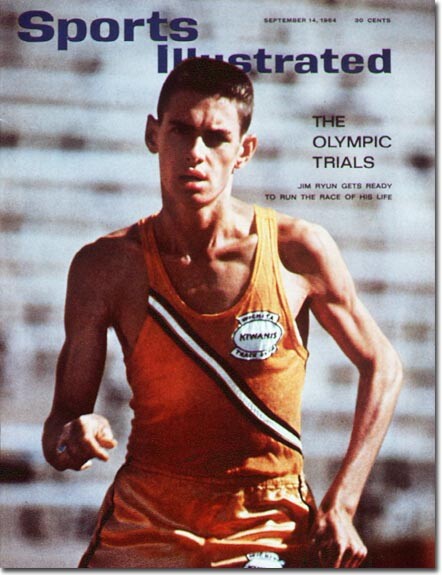
The Latest High School Runners to Break Four Minutes
The most recent athletes to achieve the sub-4-minute mile in high school competition are:
- Drew Griffith – 3:57.72 (May 30, 2024, Festival of Miles, St. Louis, Missouri)
- JoJo Jourdon – 3:59.87 (February 3, 2024, New Balance Indoor Grand Prix, Boston, Massachusetts)
- Zachary Hillhouse – 3:59.62 (June 16, 2024, New Balance Nationals Outdoor, Philadelphia, Pennsylvania)
- Owen Powell – 3:57.74 (February 15, 2025, UW Husky Classic, Seattle, Washington)
These runners continue to prove that the sub-4-minute mile, once thought to be nearly impossible for young athletes, is an achievable milestone with the right combination of talent, training, and opportunity.
Jim Ryun and Alan Webb: The Legends of the High School Mile
Jim Ryun: A Historic Career
Jim Ryun was the first high school runner to break the 4-minute mile, running 3:59.0 in 1964 as a junior. He later set the national high school record of 3:55.3 in 1965, a time that stood for 36 years.
After his historic high school career, Ryun went on to break the world record in the mile twice—first in 1966, and then again in 1967 when he ran 3:51.1. At 19 years old, he remains the youngest world record holder in the mile to date. His record stood for nine years before being broken in 1975.
Ryun represented the United States in three Olympic Games (1964, 1968, and 1972), winning a silver medal in the men’s 1500m at the 1968 Olympics. His dominance in middle-distance running made him one of the greatest milers in history.
Alan Webb: The New Generation's Record-Breaker
In 2001, Alan Webb broke Ryun’s long-standing high school mile record by running 3:53.43 at the Prefontaine Classic. Webb’s performance redefined expectations for young milers and set a new benchmark for high school runners.
Webb continued his success post-high school and later set the American record in the mile, running 3:46.91 in 2007. This remains one of the fastest mile performances ever by an American.
Despite his success, Webb’s professional career was marked by injuries, including Achilles tendonitis and stress fractures, which affected his consistency. However, his high school and professional achievements cemented his place as one of the greatest milers in U.S. history.
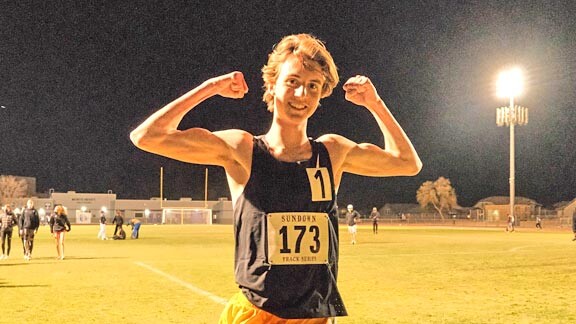
The Complete List of High School Sub-4 Milers
Below is the full list of American high school runners who have broken the 4-minute mile, ranked by their fastest time achieved during high school competition:
- Alan Webb (first photo) – 3:53.43 (May 27, 2001, Prefontaine Classic, Eugene, Oregon)
- Jim Ryun (second photo) – 3:55.3 (June 27, 1965, AAU Championships, San Diego, California)
- Colin Sahlman (third photo) – 3:56.24 (May 28, 2022, Prefontaine Classic, Eugene, Oregon)
- Drew Griffith – 3:57.72 (May 30, 2024, Festival of Miles, St. Louis, Missouri)
- Hobbs Kessler – 3:57.66 (February 7, 2021, American Track League Invitational, Fayetteville, Arkansas)
- Drew Hunter – 3:57.81 (February 20, 2016, NYRR Millrose Games, New York City, New York)
- Gary Martin – 3:57.89 (June 2, 2022, Festival of Miles, St. Louis, Missouri)
- Connor Burns – 3:58.83 (June 2, 2022, Festival of Miles, St. Louis, Missouri)
- Tim Danielson – 3:59.4 (June 11, 1966, San Diego Invitational, San Diego, California)
- Reed Brown – 3:59.30 (June 1, 2017, Festival of Miles, St. Louis, Missouri)
- Matthew Maton – 3:59.38 (May 8, 2015, Oregon Twilight Meet, Eugene, Oregon)
- Grant Fisher – 3:59.38 (June 4, 2015, Festival of Miles, St. Louis, Missouri)
- Michael Slagowski – 3:59.53 (April 29, 2016, Jesuit Twilight Invitational, Portland, Oregon)
- Leo Daschbach – 3:59.54 (May 23, 2020, The Quarantine Clasico, El Dorado Hills, California)
- Simeon Birnbaum – 3:57.53 (June 1, 2023, Festival of Miles, St. Louis, Missouri)
- Rheinhardt Harrison – 3:59.33 (June 3, 2022, Golden South Series #2, Tarpon Springs, Florida)
- Marty Liquori – 3:59.8 (June 23, 1967, AAU Championships, Bakersfield, California)
- Lukas Verzbicas – 3:59.71 (June 11, 2011, Adidas Grand Prix, New York City, New York)
- JoJo Jourdon – 3:59.87 (February 3, 2024, New Balance Indoor Grand Prix, Boston, Massachusetts)
- Zachary Hillhouse – 3:59.62 (June 16, 2024, New Balance Nationals Outdoor, Philadelphia, Pennsylvania)
- Owen Powell – 3:57.74 (February 15, 2025, UW Husky Classic, Seattle, Washington)
- Tinoda Matsatsa – 3:58.70 (June 1, 2023, Festival of Miles, St. Louis, Missouri)
- Jackson Heidesch – 3:59.08 (June 1, 2023, Festival of Miles, St. Louis, Missouri)
The Sub-4 Mile Remains an Iconic Benchmark
Roger Bannister’s 1954 breakthrough redefined human potential in distance running, and the high school sub-4-mile club continues to grow. As competition and knowledge improve, the question isn’t whether more young runners will join the club, but just how fast the next generation can go
Login to leave a comment
Wilson, at 16, becomes youngest male USA track Olympian
Quincy Wilson, at age 16, could become the youngest American male athletics competitor to appear at an Olympics as a member of the 4x400m relay pool at Paris.
Wilson finished sixth in the 400m final in 44.94secs, missing out on an individual spot, but USA Track and Field's relay selectors delivered the news Sunday he was in the relay group.
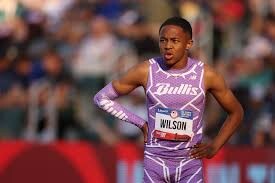
"WE GOING TO THE OLYMPICS," Wilson posted on Instagram.
The previous youngest US athletics competitor at an Olympics was Jim Ryun, who was 17 years and 137 days when he ran at the 1964 Tokyo Olympics.

Wilson, about to start his junior year at Bullis School in Potomac, Maryland, twice broke the under-18 world record for 400m during last week's US trials in Eugene, Oregon.
He broke the age group world record with a run of 44.66secs in the preliminary heats, then lowered that two-day-old mark with a 44.59-second effort in the semi-finals.
by AFP
Login to leave a comment
U.S. Olympic Team Trials Track And Field
Eugene, Oregon has been awarded the 2024 U.S. Olympic Team Trials - Track & Field, USA Track & Field and the U.S. Olympic & Paralympic Committee announced today. From June 21 to 30, Hayward Field at the University of Oregon will be home to one of the biggest track and field competitions in the country, as the U.S. Olympic Team...
more...Five high school boys have combined to break the four-minute barrier seven times in 2022 and no one has enjoyed it more than Jim Ryun
Jim Ryun was the first high school boy to break the four-minute barrier in the mile as a Kansas 17-year-old in 1964 and went on to a legendary track and field career that included three Olympic appearances in the 1,500m, a silver medal in the 1968 Mexico City Olympics, and numerous American and world records.
Ryun’s name always surfaces when a high schooler dips under 4 minutes in the mile. And in 2022, his name has been coming up a lot.
Ryun’s career was also in the spotlight earlier this month when he was one of 30 former college track and field athletes inducted into the inaugural class of the USTFCCCA’s Athlete Hall of Fame in conjunction with the NCAA Championships in Eugene, Ore.
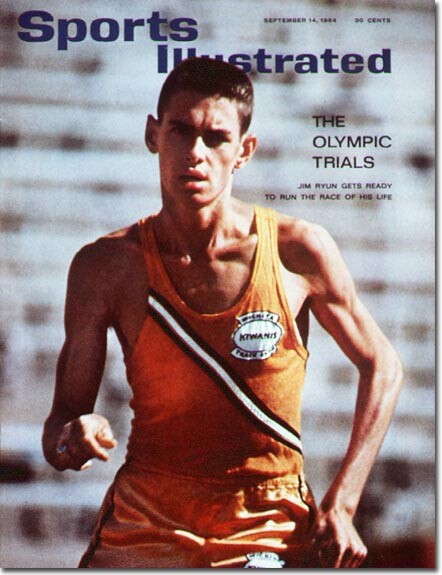
The original 4-minute high school barrier breaker celebrates the resurgence of American high school distance running and says for too long runners were held back in fear of what would happen if they ran under 4 minutes for the mile.
“I think they realize it’s not a barrier that can’t be broken, it’s more of a matter that if you break it,” Ryun said, “will you go on from there, which you can because we’re seeing more and more of them that are doing that.
“It’s not the barrier that it once was, should never have been there. For a long time, there were three of us. Myself, Marty Liquori and Tim Danielson. We were the only (sub) 4-minute milers from high school for years and I think it was the result of people being afraid of that, and coaches saying if you run too fast, too soon you’ll never make it very far.”
Growing up, Ryun often wondered if he would ever be successful in an athletic endeavor. He tried basketball and football and was cut from his church baseball team. At a high school assembly, Bob Timmons, the school’s track and field and cross country coach, encouraged students to run on his cross country team in the fall.
Ryun had never run more than one lap around a track before joining the cross country team, but in one season at Wichita East High School, he went from the last runner on the third-string team to a sixth-place finish at the Kansas state meet.
“Running was so new to me, I didn’t know who the heroes were,” Ryun recalled. “In fact, my first thought was I wanted to be a baseball, football, basketball player. Running, what’s that? So, it took a while. The first book Coach Timmons gave to me was about Emil Zatopek, the great Olympian, so I read that, and it began helping me understand about the sport.”
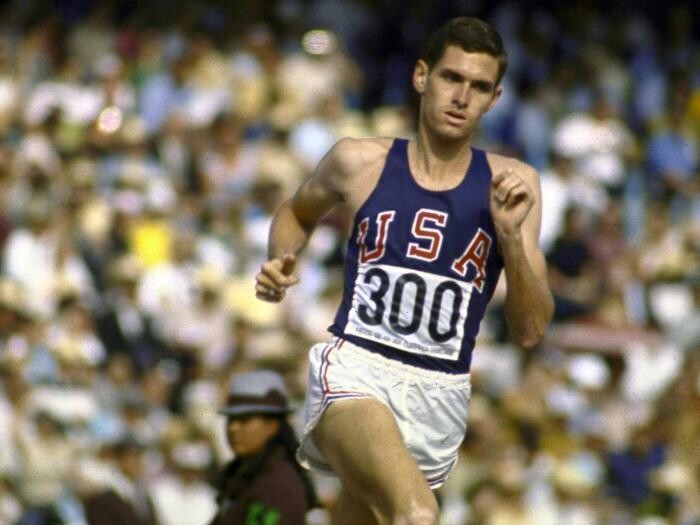
Ryun said Timmons was convinced he could be the first high school runner to break 4 minutes in the mile. That came true on June 5, 1964, when Ryun ran 3 minutes, 59.0 seconds to finish eighth at the Compton Invitational in Los Angeles.
“The goal originally was my coach’s because I was the kid that got cut from the church baseball team, didn’t have great talent and when I started running, I was looking for direction,” Ryun said. "And he began basically teaching me about goals, how to reach goals, and gave me workouts to get there. The night that I ran 4 minutes, 3:59.0, I didn’t sleep that night (before) because I realized that it was his goal.
“But my thought was, what happens if I take ownership, ownership being there’s certain things you as an athlete know you could do like maybe a little extra weightlifting, better eating. It was a transformational moment, because I mean when you finish eighth in a race and become the first kid to run under 4 minutes, that has to change your life – and it did.”
Ryun’s running career took off from there. He made the 1964 U.S. Olympic team in the 1,500m that went to Tokyo and was the last U.S. high school men’s track and field athlete to make the U.S. Olympic team until teenager Erriyon Knighton qualified for the 2020 Tokyo Olympics in the 200m and finished fourth there.
As a high school senior, Ryun broke 4 minutes four more times. His time of 3:58.3 at the 1965 Kansas state meet was the first time 4 minutes was broken in a high school-only meet. On June 4, 1965, Ryun returned to the Compton Relays, the site of his first sub-4-minute mile and ran 3:56.8. A little over three weeks later, he ran 3:55.3 at the U.S. AAU Championships in San Diego and beat New Zealand’s Peter Snell, the 1964 Olympic champion in the 800m and 1,500m.
Ryun, who would stay close to home and attend Kansas University after graduating from high school in 1965, roomed with a former Jayhawks great, Billy Mills, during U.S. training camps leading up to the 1964 Olympics. In Tokyo, Mills stunned the world by becoming the only U.S. athlete to ever win the Olympic 10,000m.
In 1966, Tim Danielson became the second American high schooler to break 4 minutes when he ran 3:59.4. A year later, Marty Liquori ran 3:59.8 to become the third high schooler under 4 minutes.
Ryun and Liquori had illustrious careers after high school, particularly Ryun. At age 19 in 1966, Ryun set two world records, first in the 800m (1:44.9), and then the mile (3:51.3). He was the NCAA indoor mile champion for Kansas in 1967, 1968 and 1969, and the 1967 outdoor NCAA mile champion. In 1967, he set a 1,500m world record of 3:33.1 that stood for seven years.
That same year, he lowered his mile world record to 3:51.1., a mark that stood for almost eight years. Ryun was the last American man to hold the mile world record. He still holds American junior records for the mile (3:51.3) and 2-mile (8:25.1), and his 800m American junior record of 1:44.9 stood for exactly 50 years.
In 2003, ESPN.com ranked Ryun as the greatest U.S. high school athlete of the 20th century, ahead of Tiger Woods, LeBron James, Lew Alcindor (now Kareem Abdul-Jabbar), Wilt Chamberlain, Marion Jones, and others.
After Ryun, Danielson, and Liquori, the 4-minute mile wasn’t broken by a prep athlete again for more than 32 years until Alan Webb ran 3:59.86 at the New Balance Games in New York on Jan. 20, 2001. Sensing something special in Webb, the promoters of the Prefontaine Classic in Eugene, Ore., invited him to run in the Bowerman Mile, the signature event of the meet that has since become a Diamond League event, on May 27, 2001.
Morocco’s Hicham El Guerrouj, still the world record-holder in the 1,500m and mile, won the event in 3:49.92, followed by Kevin Sullivan of Canada and Bernard Lagat, then of Kenya, who later ran for the U.S. They helped pull Webb to a fifth-place finish in 3:53.43, breaking Ryun’s 36-year-old high school record.
“I thought he would. I just didn’t know how much he would break it by," Ryun said. “It was one of those moments in time where he had run well, but he needed somebody to help him get over that finish line, just as I did running under 4 minutes for the first time. You need someone to help set the pace. You can relax a little bit, and he was able to take advantage of that.
“So, there was no real surprise to me. The biggest surprise was that there weren’t more high school boys running under 4 minutes.”
It would be another 10 years before a high schooler would break 4 minutes in the mile. In 2015, Matthew Maton and Grant Fisher, now the U.S. record-holder in the men’s 10,000m, both ran 3:59.38 about one month apart. In 2016, two runners broke 4 minutes, including Drew Hunter, who did it twice in a 15-day span in February indoors, both times in New York.
The 4-minute barrier was broken by high schoolers once in 2017 and again in 2020 during the height of the COVID-19 pandemic. In 2021, Hobbs Kessler ran the fastest high school mile since Webb when he ran 3:57.66 indoors. Kessler later that year broke Ryun’s 1,500m American junior record of 3:36.1 that stood for almost 55 years.
The lack of American high school runners breaking 4 minutes in the mile for decades might be a big reason why U.S. men haven’t enjoyed much Olympic or international success until recently. When Matthew Centrowitz won the men’s 1,500m at the 2016 Rio de Janeiro Olympics, he was the first American man to do so since 1908. At the same Olympics, Clayton Murphy won the bronze medal in the 800m, the first American man to medal in the event since 1992.
And when the World Athletics Championships are hosted on U.S. soil for the first time next month in Eugene, Ore., the defending 800m men’s champion is American Donavan Brazier.
“If you look back in history, you’d see there was a dominance maybe by a country for a time like Great Britain had all those great runners. America at one time was dominant in that area as well,” Ryun said. “So, I think it’s a matter of floating from place to place, and I think it comes down to motivation. How motivated are you?
“Over time you start realizing that motivation has to come down to you be willing to get up, run in all kinds of weather, race all over the world and let those talents be developed that God’s given you. So, it takes time. I think America can come back with dominance, but it also comes down to how motivated you are. I see the Kenyans as very motivated, and America can be just as motivated as you see with these new young runners that are developing quickly.”
That has proven to be the case this season. Seventeen high school runners have broken the 4-minute barrier, and 2022 has been the banner season for it so far with five runners breaking the mark seven times.
“I think a lot of coaches are seeing, too, that kids are just developing a lot faster doesn’t mean you’re going to burn out,” Ryun said. “It means you’ve got great opportunities. Will you decide to keep it going and, in my case, will you take ownership? The coach can only take you so far, but then you have to establish ownership.”
The owner of the fastest prep mile this year is Colin Sahlman, who ran 3:58.81 indoors in February, and, like Webb, was invited to the Bowerman Mile at the Prefontaine Classic. In a field that included 2020 Tokyo Olympic 1,500m gold medalist Jackob Ingebrigtsen, defending World Athletics Championships 1,500m gold medalist Timothy Cheruiyot, and defending 1,500m NCAA outdoor champion Cole Hocker, Sahlman finished 13th in 3:56.24. Of the 14 men who finished the race, seven set personal bests and seven set season bests, including Ingebrigtsen, whose time of 3:49.76 is the fastest in the world this year.
Sahlman’s time moved him to third on the all-time prep list behind Webb and Ryun. Sahlman, who is headed to Northern Arizona University for college, was part of a high school powerhouse at Newbury Park High in Southern California. In 2021, Newbury Park became the first high school team to have four runners break 4:10 for the mile in the same season.
“That mindset has really evolved and developed over these last three to four years,” Sahlman said in a March article in the Los Angeles Times. “It’s just like it’s transformed into something that we never thought was possible. Now we think anything’s possible.”
Gary Martin has also broken 4 minutes twice this year, running 3:57.98 on May 14 and 3:57.89 on June 2 in the Festival of Miles in St. Louis. At the Festival of Miles, Connor Burns ran 3:58.83 to become the first high school junior since Ryun to break 4 minutes. It was also the first time two prep runners broke 4 minutes in the same race.
Those two performances gave the Festival of Miles four prep runners who have broken 4 minutes. That’s where Fisher did in 2015, a feat repeated by Reed Brown a year later.
And one day after Martin and Burns broke 4 minutes, Rheinhardt Harrison ran 3:59.33 in Florida on June 3. On June 15, Simeon Birnbaum added to the list of sub-4 minute runners when he became the second high school junior this season to break the mark with a time of 3:59.51.
Will this high school running resurgence lead to greater U.S. success against international competition and major global championships? Only time will tell.
by Ashley Conklin (World Athletics)
Login to leave a comment
Prefontaine Classic promises world record attempts and rich competition despite late losses
It is a measure of Eugene’s Prefontaine Classic meeting - which tomorrow forms the third stop on the Wanda Diamond League tour - that it can lose four Olympic gold medalists at late notice and still remain packed with compelling competition and world record attempts.
The arrangement of all that athletics action was altered today following forecasts of rain and high winds - likely to be blowing into the faces of the sprinters - on Saturday.
Accordingly the men's pole vault, featuring Olympic gold and silver medalists Mondo Duplantis of Sweden and Chris Nilsen of the United States, the women's discus, featuring the US Olympic champion Valarie Allman, and the women's high jump, involving Ukraine's world indoor champion Yaroslava Mahuchikh, have been moved to Friday night's programme, where world record attempts are being made over two miles and 5,000 meters.
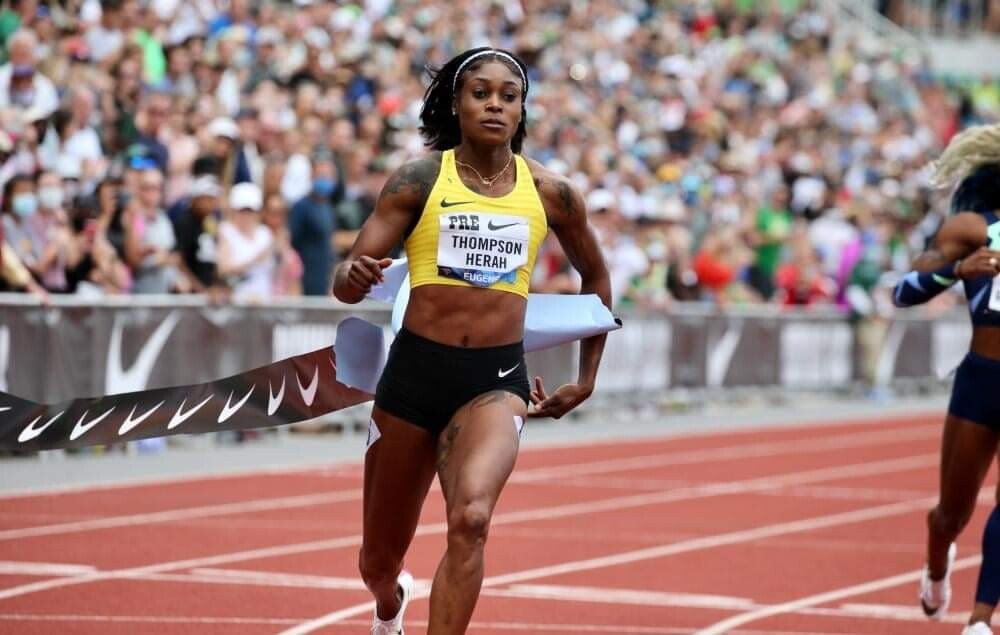
The news that the United States' Olympic women’s 800 meters champion Athing Mu will not now race against Britain’s Tokyo 2020 silver medalist Keely Hodgkinson, and that Italy’s men’s 100m champion Marcell Jacobs will not be in a field including the man he beat to gold in Japan, home sprinter Fred Kerley, was disappointing.
Also missing from the planned line-up at the new-look Hayward Field, which will stage this year’s World Athletics Championships, are home talents Matthew Centrowitz, the Rio 2016 1500m gold medalist, Tokyo 2020 and world 400m hurdles silver medalist Rai Benjamin and double world pole vault champion Sam Kendricks.
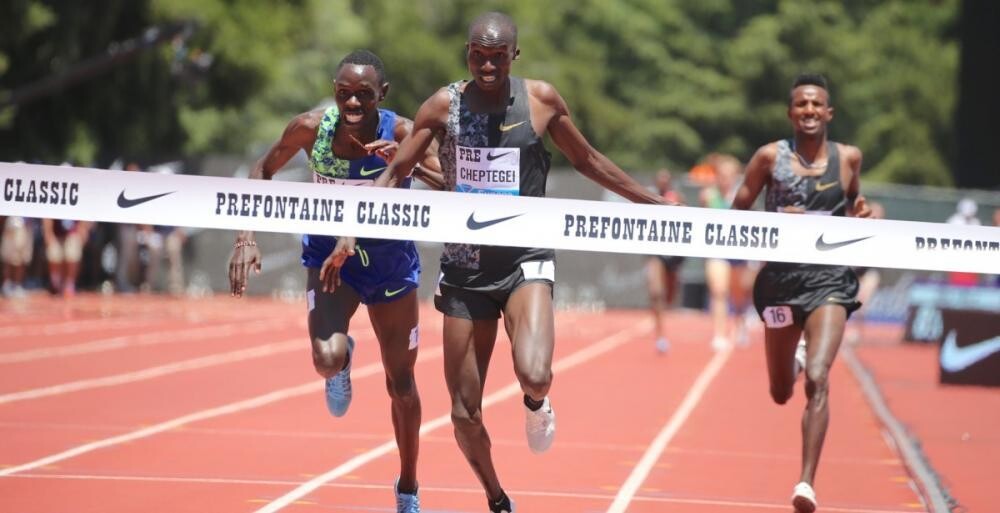
And South Africa’s double Olympic 800m champion Caster Semenya, who had planned a first top-level race since 2019, has also withdrawn.
All this means the limelight will shine all the more intensely on stellar performers such as Jamaica’s double Olympic women’s 100 and 200m champion Elaine Thompson-Herah, who runs over the shorter sprint against a field including the American who missed last year’s Olympics because of a three-month suspension after testing positive for cannabis, Sha’Carri Richardson.
Britain’s world 200m champion Dina Asher-Smith, who last Saturday won the Birmingham Diamond League 100m from which Thompson-Herah had made a late withdrawal, is also in the mix, as is Switzerland’s world indoor 60m champion Mujinga Kambundji and Jamaica’s Tokyo 2020 bronze medalist Shericka Jackson.
Thompson-Herah chose to make a low-key start to her outdoor season, choosing to compete in Kingston, where she clocked 10.94sec despite a strong headwind of -1.8 meters per second.
It was on this track last year that she ran 10.54, putting her second on the all-time list.
The men’s 100m is also loaded given the presence of Kerley and his fellow Americans Trayvon Bromell, who will be keen to restore normal working after his early exit in Birmingham because of a false start, world champion Christian Coleman, world 200m champion Noah Lyles and Canada’s Olympic 200m champion Andre De Grasse.
And 18-year-old Erriyon Knighton, who last year became the youngest male athlete to represent the United States since middle distance runner Jim Ryun in 1964 and missed a 200m medal by one place, will seek to break 10sec for the first time.
Knighton already tops this year’s 200m world list with his startling 19.49sec in Baton Rouge last month, which put him fourth on the all-time list.
The women’s 200m will see double Olympic 400m champion Shaunae Miller-Uibo taking on Jamaica’s 35-year-old Beijing 2008 and London 2012 100m champion Shelly-Ann Fraser-Pryce, who won world gold at this distance in 2013 and took silver at the London 2012 Olympics.
The men’s 400m will see Kirani James of Grenada, the London 2012 champion and Tokyo 2020 bronze medalist, take on home athletes including Michael Cherry, Michael Norman – a major talent currently seeking a performance to do himself justice - Vernon Norwood and Kahmari Montgomery.
The absence of Benjamin from the 400m hurdles will offer Brazil’s Tokyo 2020 bronze medalist Alison Dos Santos - who beat Benjamin in the opening Diamond League meeting of the season in Doha – a perfect chance to shine,
In the women’s 100m hurdles, Puerto Rico’s Olympic champion takes on the American who took silver behind her in Tokyo, world record holder Kendra Harrison.
The traditional Friday evening distance racing in Eugene will include a women’s two miles and a women’s and men’s 5000m race.
At the latter, which will be followed by an official Diamond League 5,000m on Saturday, Uganda’s Joshua Cheptegei is billed to make an attempt at breaking his own world record of 12min 35.36sec, which he ran in Monaco in August 2020.
On Saturday afternoon the majority of the rivals Cheptegei beat to win Olympic 5,000m gold in Tokyo last year will line up for the Diamond League 5.000m, where Olympic 10,000m champion Selemon Barega of Ethiopia, Olympic 10,000m bronze medalist Jacob Kiplimo of Uganda, Olympic 5,000m silver Mohammed Ahmed of Canada and two-time Olympic 5,000m medalist Paul Chelimo of the United States are the main contenders.
Friday night will also see Ethiopia’s 24-year-old Letesenbet Gidey aiming to lower the women’s 5000m world record of 14:06.62 that she set in Valencia in October 2020.
Gidey has since lowered the women’s 10,000m world record to 29min 01.03sec and the world half marathon record to 1hr 2min 52sec.
Elsewhere on Friday, the women’s two miles will see Sifan Hassan of the Netherlands, the Olympic 5,000 and 10,000m champion, facing Diamond League 5,000m champion Francine Niyonsaba of Burundi.
The latter, who was disqualified at the Tokyo 2020 Games, beat Kenya’s double Olympic 1500m champion Faith Kipyegon over 3,000m in Doha earlier this month.
The world best of 8:58.58, set by Ethiopia’s Meseret Defar in 2007, is sure to be under threat.
Saturday’s middle-distance action will be highlighted by the clash of Olympic 1500m champion Jakob Ingebrigtsen and world champion Timothy Cheruiyot, who renew their rivalry in the Bowerman Mile.
Ingebrigtsen beat Cheruiyot for the first time in the Olympic final in Tokyo last year but the Kenyan beat his Norwegian rival a few weeks later to win over 1500m at the Diamond League final in Zurich.
Both men will need to be primed, however, to beat Kenya’s Abel Kipsang, who out-kicked Cheruiyot to win in Doha recently and who backed it up with 1500m victory in Birmingham last Sunday.
Kipyegon meanwhile will take on Britain’s Tokyo 2020 silver medalist Laura Muir and Gudaf Tsegay of Ethiopia in the women’s 1500m.
Hodgkinson faces an 800m field that includes home runner Ajee Wilson, who took the world indoor title earlier this year.
The men’s shot put will involve the respective Tokyo 2020 gold, silver and bronze medalists Ryan Crouser and Joe Kovacs of the United States and New Zealand’s Tom Walsh.
by Mike Rowbottom
Login to leave a comment
Prefontaine Classic
The Pre Classic, part of the Diamond League series of international meets featuring Olympic-level athletes, is scheduled to be held at the new Hayward Field in Eugene. The Prefontaine Classicis the longest-running outdoor invitational track & field meet in America and is part of the elite Wanda Diamond League of meets held worldwide annually. The Pre Classic’s results score has...
more...Gary Martin goes 3:57.98 (third fastest high schooler ever behind only Alan Webb and Jim Ryun) to win today's Philadelphia Catholic League Championsips
Another day, another milestone for Gary Martin. And this one was a biggie.
The Archbishop Wood High School senior ran a sub-four minute mile Saturday at the Catholic League championships at Cardinal O'Hara.
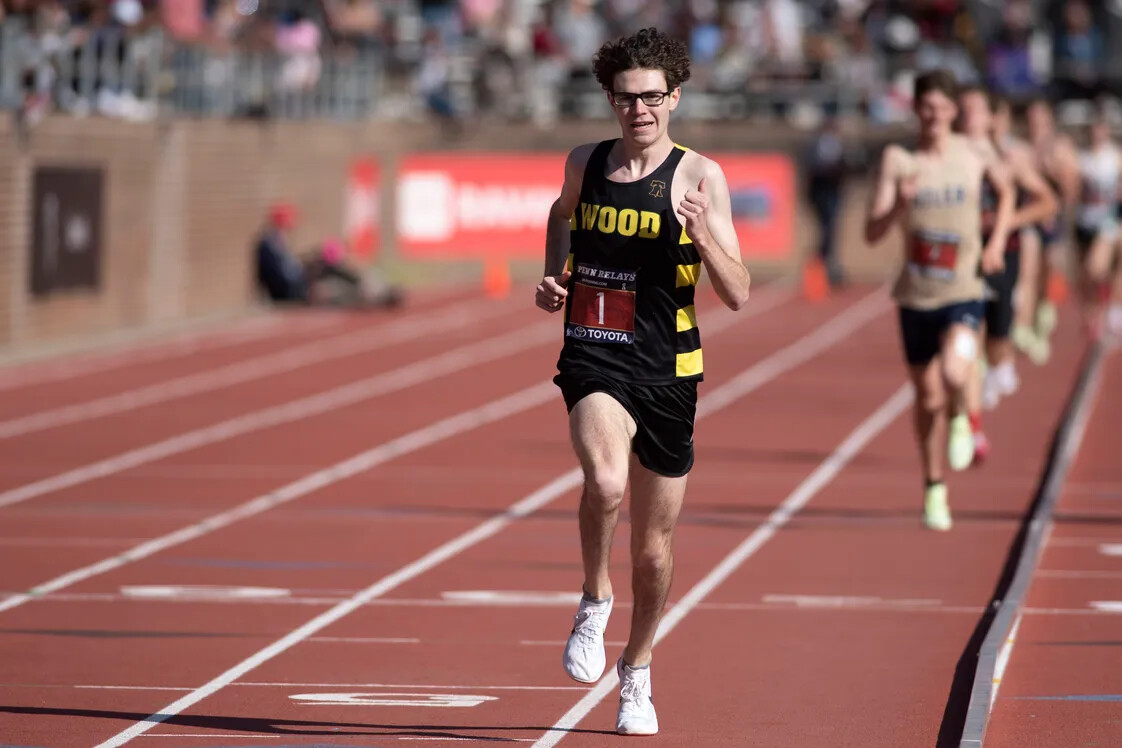
After just missing the milestone at the Penn Relays, he ran Saturday's race at 3:57.98. It was the 20th time a high school runner accomplished the feat, and his time was the sixth fastest ever for a high school student. Overall, he was the 14th runner to break the four-minute mark and it was the fastest time in state history. It was the first in the state to break the 4-minute mark.

Martin has been breaking records all year, beginning in cross country, and continuing during the indoor and outdoor seasons.
Last week Martin broke the state record in the 3,200-meter run, posting a 8:41.57 mark to break Robert DiDonato’s record of 8:44.98 set at this meet last year.
The University of Virginia signee will have more chances to smash records at the state meet.
The Archbishop Wood senior has been on a quest to become the first Pennsylvania high school athlete ever to run a sub-four-minute mile.
Running with a purpose and leading from the start, Martin made history with a sizzling time of 3:57.98.
Martin raised his hands in triumph as he crossed the finish line. His time was the fastest in the county by nearly 10 seconds.
“I’ve had a couple of really good workouts this week and I felt I was in shape to do it,” Martin said. “Looking at the weather, I thought it was going to be a good day and it’s one of my last opportunities to really just run an all-out mile before we get into postseason stuff. I just wanted to go for it, see how I was feeling through two laps. I felt good. I was right on so I kept going.”
Martin found the warm conditions with a light rain to his liking as he took the lead in the first 50 meters and kept his foot on the gas. He ran the first quarter in 59.67 seconds, the second in 58.79, the third in 59.87 and the final in 59.62 to obliterate the meet record of 4:14.08 set by O’Hara’s Steve Hallinan and take his place in history.
“For me, I like to run even splits,” Martin said. “I like to settle into a pace, find a pace I need to run and then hold on throughout, which is what I did today. That’s kind of the goal going in. You just have to stay mentally tough.”
Martin wasn’t done for the day. He also won the 800 in a meet-record time of 1:51.29, to break the mark of 1:52.95 set by O’Hara’s Pat Nash in 2000. And Martin anchored Wood’s 4 x 400-meter relay team to a silver medal by two-tenths of a second to take home the outstanding boys track performer of the meet away.
Login to leave a comment
A new generation of champions set to emerge in Tokyo
While some reigning Olympic and world champions might be missing from the Games in Tokyo, the extra year as a result of the postponement in 2020 has allowed a number of new talents to emerge.
For some it means a debut Olympic experience which may not originally have been expected until at least 2024, while for others it is a realistic opportunity to win medals and titles.
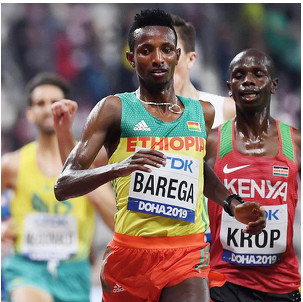
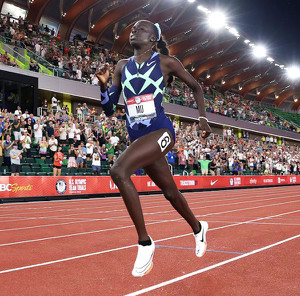
Of the 43 individual events contested at the Rio 2016 Olympics, the winners from just 18 of those will defend their titles in Tokyo.
The likes of world 800m champion Donavan Brazier and Olympic 110m hurdles champion Omar McLeod missed out on being selected for their national team, while other stars, such as world and Olympic triple jump champion Christian Taylor, are currently sidelined with injury.
But while those global champions won't be able to contend for top honours in Tokyo, here are some of the new generation of stars who are set to emerge.
Selemon Barega, 10,000m
After winning world U18 and U20 titles in 2017 and 2016 respectively, Ethiopia’s Barega stepped up to secure senior 5000m silver at the World Athletics Championships in 2019. Still aged just 21, he is now preparing for his debut Olympics, where he will race the 10,000m.
Barega started the season with intent, running an Ethiopian all-comers’ record of 27:58.5 at altitude in Addis Ababa in January. He then went even faster at the Ethiopian Trials in Hengelo in June, clocking 26:49.51 on the same track on which he ran his 26:49.46 PB in 2019. That, together with the speed he demonstrated by running PBs of 3:32.97 for 1500m and 7:26.10 for 3000m during the indoor season, means he is set to be a strong force in Tokyo
Jasmine Camacho-Quinn, 100m hurdles
Medal success in Tokyo would see Camacho-Quinn become the first Puerto Rican woman to secure an Olympic podium place in athletics and this season she has certainly demonstrated her ability to achieve that feat.
The 24-year-old improved her own national 100m hurdles record to 12.32 to move to equal seventh on the world 100m hurdles all-time list in Eugene in April and hasn’t been beaten since. She clocked 12.38 to win at the Wanda Diamond League meeting in Florence and 12.34 for success in Szekesfehervar, meaning she has the three fastest times in the world so far this year. “I'm looking forward to the Olympics this year - it will be like redemption from my fall in 2016,” she said after her Florence run as she reflected on missing out on the final in Rio. “I'm really excited. Training really hard, working really hard, but really looking forward to it.”
Tara Davis, long jump
Davis leapt into the seven-metre club in March, breaking the US collegiate long jump record with 7.14m at the Texas Relays. The longest jump in the world since the 2019 World Athletics Championships final, that mark moved the 22-year-old to fifth on the US all-time list.
The world U20 bronze medallist had also broken the collegiate indoor record with 6.93m at the NCAA Indoor Championships earlier in the year and finished second at the US Olympic Trials, going beyond seven metres again with a best of 7.04m. “I’m shocked still because seven metres as a jumper is the biggest thing ever. Hitting it in the Olympic Trials is unreal,” she said after her performance in Eugene, where she finished second to four-time world gold medallist and 2012 Olympic champion Brittney Reese. “I’m freaking jumping with my idol, Brittney Reese. Being with her and competing with her in 2016 I was so starstruck. I was like, ‘I see her on TV and now I’m jumping with her’.”
Alison Dos Santos, 400m hurdles
After running in the lane next to Karsten Warholm during his world record in Oslo, improving his South American record to 47.38 to finish second, Brazil’s Dos Santos went even quicker to win three days later in Stockholm, taking another 0.04 off that mark.
This season has seen the 21-year-old build on his 2019 breakthrough, having that year improved his PB and the South American U20 record seven times, eventually clocking 48.28 to finish seventh at the World Athletics Championships in Doha. Also a key member of Brazil’s relay team, he ran the fastest split of the mixed 4x400m final at the World Athletics Relays in Silesia, recording a 44.62 anchor leg. “I'm looking forward to the Olympics, and yes, I think I can get a medal,” he said with a smile after his run in Stockholm.
Mondo Duplantis, pole vault
While some may argue that a world record (or two) rules an athlete out from being considered part of a ‘new generation’, pole vault star Duplantis is still aged only 21 and has much more he hopes to accomplish during his career, including winning Olympic gold.
This season he has cleared six metres or higher in four competitions, capped by his 6.10m in Hengelo - a height only he, Renaud Lavillenie and Sergey Bubka have ever achieved. After winning 2019 world silver behind Sam Kendricks - who ended Duplantis’ 23-competition win streak in challenging conditions in Gateshead in May - Duplantis will be looking to go one better in Tokyo. He also believes he can go higher than his 6.18m world record this season and after attempting 6.19m in Oslo, he said: “I really think I can get that record soon. But for now I feel good, a month away from the most important meet of my life. I am in good shape, I am running well on the runway and keeping up the rhythm well.”
JuVaughn Harrison, long jump and high jump
Harrison secured his two Olympic spots in style at the US Trials, soaring over 2.33m and then leaping a PB of 8.47m to improve his own best-ever single-day high jump and long jump double. As a result, he will become the first male athlete to represent the USA in both events at the Olympics since Jim Thorpe in 1912. No other athlete has ever achieved both a 2.30m high jump and 8.40m-plus long jump.
The 22-year-old is no stranger to juggling both events on the same day and in March he cleared 2.30m and jumped 8.45m at the NCAA Indoor Championships. In Tokyo, the high jump final is on the evening of day three and the long jump final is on the morning of day four. He is expecting to rise to the challenge. “It will be harder competition which will make me push harder and jump farther,” he said.
Erriyon Knighton, 200m
Running 19.88 at the age of just 17, Knighton broke not one but two world 200m age-group bests which had previously been held by a certain Usain Bolt. At the US Olympic Trials, the former American football player ran 20.04 in the heats to improve Bolt’s world U18 best before taking 0.16 off that mark in the semifinals to break the world U20 record of 19.93 set by Bolt in 2004. In the final he went quicker still, clocking 19.84 to finish third and become the youngest man to represent the USA in athletics at the Olympics since Jim Ryun in 1964, also in Tokyo.
Racing outside of the USA for the first time, Knighton then placed third at the World Athletics Continental Tour Gold meeting in Szekesfehervar, running 20.03. “It hasn't sunk in, it’ll probably sink in when I get home,” he said after claiming his Olympic place. “I'm happy. I feel it's a really big achievement.”
Nicola McDermott, high jump
As an eight-year-old, McDermott dreamt of becoming a consistent two-metre-plus international high jumper and having already achieved the latter, this year her two-metre aim was accomplished, too. Clearing 2.00m at the Australian Championships in April, the 24-year-old broke Eleanor Patterson’s Oceanian record and then added another centimetre to the mark in Stockholm earlier this month, despite not feeling 100 percent.
McDermott didn’t manage to register a height when she made her World Athletics Championships debut in London and two years later the Commonwealth bronze medallist finished 15th in qualifying. This time, as she makes her Olympic debut, her mind is on medals. “I’m not going to say it’s impossible to get a medal,” she said. “I’ll be aiming and I think 2.01m will maybe get me in the medals so I am aiming and training for that and believing that I can do it.”
Sydney McLaughlin, 400m hurdles
Like Duplantis, McLaughlin is already a world record-breaker having taken the 400m hurdles to another level with her time of 51.90 at the US Olympic Trials. She also was no stranger to making history before that, with world U18 best and world U20 record times among her age-group accomplishments.
Now aged 21, she made her first Olympic team at just 16, finishing fifth in her semifinal nine days after her 17th birthday, and then secured silver at the 2019 World Athletics Championships in Doha, a race won by her compatriot Dalilah Muhammad in a world record of 52.16. It was that mark McLaughlin improved in Eugene. “So many amazing women have come before me and will come after me,” she said after her world record. “I'm excited for what the future holds. I just want to leave my mark and be part of such an amazing sport, because the glory isn't forever.”
Athing Mu, 800m
Mu is another athlete to have risen impressively through the ranks, having stormed into the spotlight in 2019 when as a 16-year-old she ran the second-fastest ever indoor 600m time of 1:23.57. This year she has broken the world U20 indoor 800m record with 1:58.40 and then dominated the two-lap final at the US Olympic Trials, running a world-leading 1:56.07 to improve her own North American U20 record.
The 19-year-old also ran an area U20 record in the 400m with 49.57 to win the NCAA title earlier in the month. “This is my first year coming out here running to my potential,” she said after her trials win. “I wouldn't want to say I'm dominant at it yet. My confidence takes a lot from it. In 2019, I wasn't confident, but I was good enough. Gaining confidence has contributed to my dominance thus far in the 800m. Being good at it, knowing it's my event.”
Great experience
While some reigning global champions may be missing out on Tokyo, there are a number of vastly experienced stars who will be adding another Olympics to their impressive tally of major events. The USA’s Allyson Felix has already won six Olympic gold medals and 13 world titles, while shot put star Valerie Adams has claimed two Olympic and four world titles for New Zealand, with Tokyo being a fifth Olympic Games for both athletes.
Spain’s 51-year-old Jesus Angel Garcia, meanwhile, will compete at his eighth Olympics – the most ever for a track and field athlete. Who knows whether some of this new generation of stars will still be in action come the Olympic Games in 2048!
by World Athletics
Login to leave a comment
McLaughlin smashes world 400m hurdles record in Eugene with 51.90 and other highlights
In a culture saturated by so many other sports, those in the USA fret about who can be the face of athletics.
Who can be featured on television news? Who can be a crossover figure like gymnast Simone Biles? Who can be a Carl Lewis or a Jackie Joyner-Kersee?
As the 10-day US Olympic Trials closed on Sunday night (27) in Eugene, Oregon, there was a deep reservoir of young candidates – none more so than Sydney McLaughlin. The 21-year-old became the first woman to break the 52-second barrier in the 400m hurdles.
Record temperatures approaching 44C delayed the programme by five hours, but there was no delaying the inevitable: McLaughlin was going to break the world record, and she did so with her time of 51.90.
“I definitely saw it coming,” said Dalilah Muhammad, the world and Olympic champion. “She looked so good in the rounds.”
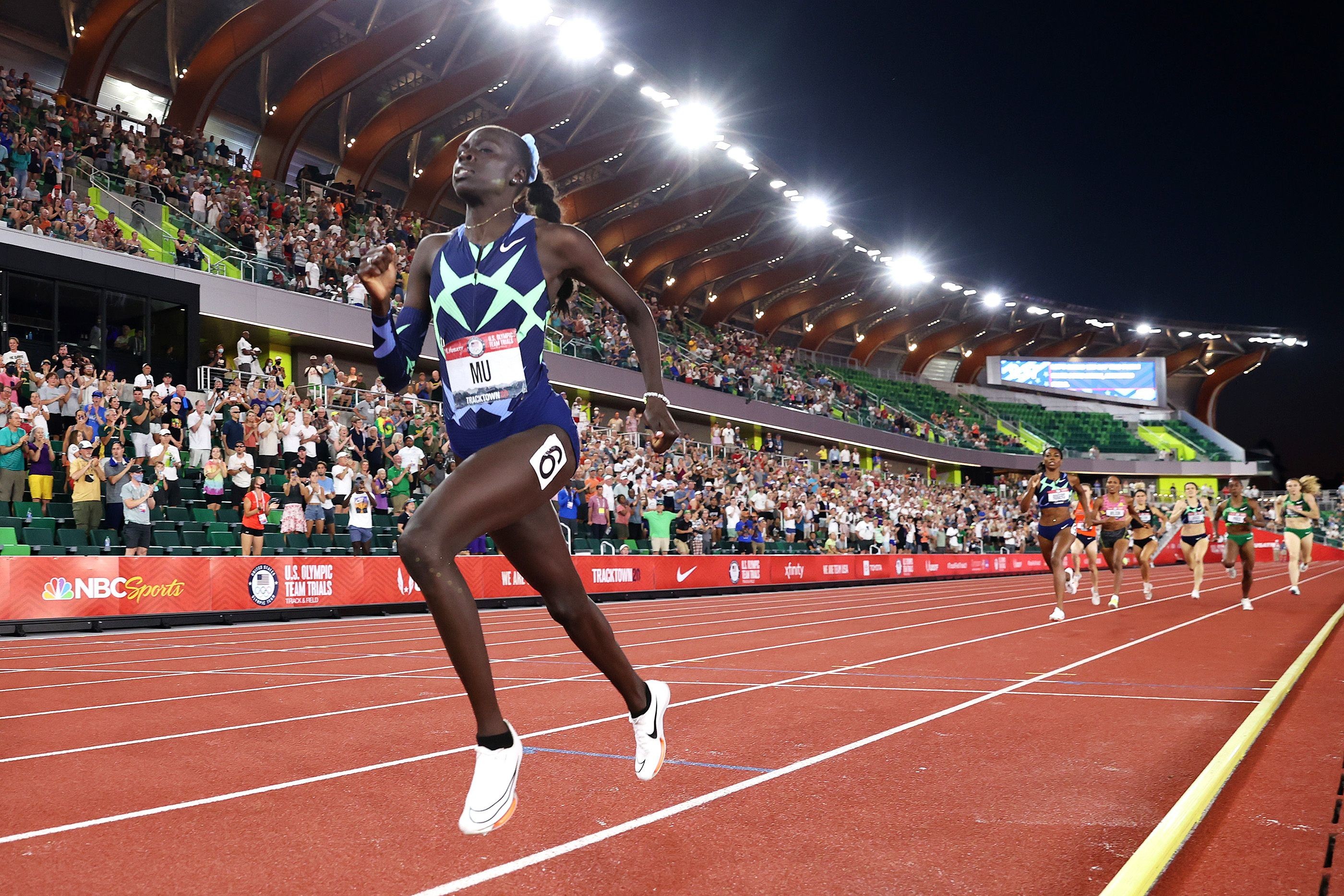
McLaughlin’s time broke the record of 52.16 set by Muhammad at the World Athletics Championships Doha 2019. McLaughlin, second in that race in 52.23, pulled away from Muhammad over the final two hurdles in Eugene.
Even with 2020 lost to the pandemic, the world record has been broken three times in 23 months – twice by Muhammad, once by McLaughlin.
That was the highlight of another historic day of young record-breakers. The trials ended with 11 world-leading marks, five by men and six by women.
Athing Mu, 19, set a trials record in the 800m; Cole Hocker, 20, became the youngest men’s 1500m champion in 110 years; JuVaughn Harrison, 22, became the first to make the US team in the high jump and long jump since Jim Thorpe in 1912; Noah Lyles, 23, ran a world-leading 200m, and Erriyon Knighton, 17, again lowered the world U20 record in the 200m.
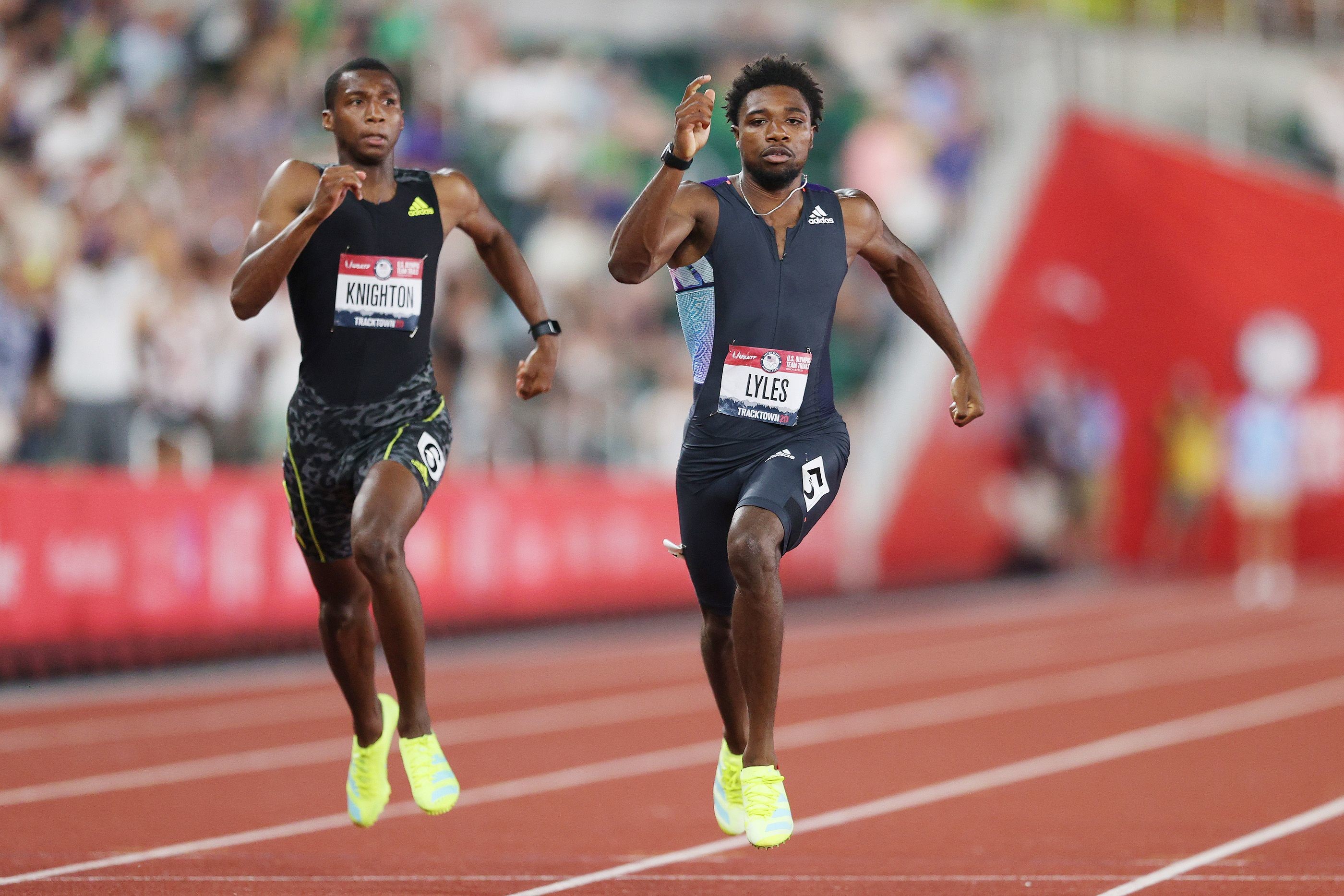
McLaughlin has been projected as the sport’s face in the United States since she made an Olympic team at age 16. After one college season at Kentucky, she turned professional.
“I was growing into my own person,” she said. “My faith is the biggest change. Trusting God and knowing He will carry me through.”
Her record-setting might not be over. Not only could McLaughlin lower her world record at the Tokyo Olympics, she should be named to the 4x400m relay team that could set one – though that mark (3:15.17) is arguably a much bigger ask.
McLaughlin trains in Los Angeles under Bobby Kersee, who also coached Joyner-Kersee.
“Bobby knows how to put things together when the time comes,” McLaughlin said.
Muhammad, who over the past 12 months has had to contend with injuries and a bout of Covid-19, finished second in 52.42, the third-fastest time of her career. NCAA champion Anna Cockrell took the third spot in 53.70, nearly a full second faster than her previous PB, in beating Shamier Little (53.85). Olympic bronze medallist Ashley Spencer stumbled over an early hurdle and finished seventh.
Likely to join McLaughlin in that 4x400m team is Mu, considering earlier this month she set a collegiate record of 49.57 – faster than the winning mark at the USA Trials.
Mu ran a world-leading 1:56.07 to win the 800m, breaking her own North American U20 record. World silver medallist Raevyn Rogers was second in a PB of 1:57.66 and US record-holder Ajee Wilson third in 1:58.39. Not until late did Wilson overtake Michaela Meyer, who was fourth in 1:58.55.
Mu sat in the pack for the first lap, passing through 200m in 27.54 and 400m in a swift 57.53. She then made her move on the second lap, positioning herself at the front with 200 metres to go. She kicked hard as she came off the final bend and, having covered the final lap in 58.54, crossed the line almost two seconds ahead of her nearest opponent.
In the men's 1500m, Hocker was in sixth place with about 150 metres left but used a closing rush to overtake Olympic champion Matthew Centrowitz, 3:35.28 to 3:35.34.
Yared Nuguse, 22, was third in 3:36.19, overtaking the most recent national champion, Craig Engels, who is also this year’s fastest US man (3:33.64).
Hocker put a finger to his lips past the finish as if to shush critics. An “in-the-moment thing”, he said.
“Last year I wasn’t at this level. I was nowhere near this level,” he said. “This whole year, I felt like I was proving myself to the world, but also proving my talent to myself. There’s a lot of negative talk out there, and I wanted to silence everyone.”
Hocker has not met the 3:35 Olympic standard but has a world ranking that looks sufficient to secure his spot on the US team.
He is the youngest US Olympian in the men’s 1500m since Marty Liquori, then 19, in 1968. And he is the youngest national champion in the men’s 1500 or mile since 1911, when Abel Kiviat won a few days after turning 19.
Hocker has run 23 races since 29 January. Thirteen were PBs. Of the 10 others, eight were prelims and one an NCAA indoor title.
“I’m impressed that he’s been able to do that since January and is showing no signs of letting up,” said Centrowitz.
Harrison won the high jump at 2.33m, beating Darryl Sullivan on countback. Olympic medallist Erik Kynard was fourth.
The delay allowed Harrison more rest for the long jump, in which he jumped a PB of 8.47m, completing the best ever one-day jumps double.
“It just gave my legs more time to recover and gave me a chance to eat something,” Harrison said. “I was ready to go earlier, even though they said it was too hot.”
Marquis Dendy, the 2016 world indoor champion, was second at 8.38m and Steffin McCarter third with 8.26m. Olympic champion Jeff Henderson was sixth with 8.08m, meaning he won’t defend his title in Tokyo.
In a competition that showcased newcomers, it was appropriate that the last athlete to secure an Olympic berth was Knighton. He is the youngest man on the US team since Jim Ryun in 1964.
World champion Lyles won the 200m in a world-leading 19.74, followed by Kenny Bednarek, 19.78, and Knighton, 19.84. Knighton broke his own world U20 record of 19.88 from Saturday’s semifinals. He set a world U18 record of 20.04 in Friday’s first round, then twice broke that.
Lyles was fourth in the 200m at the 2016 trials as an 18-year-old.
“Ever since then, the mind-set of being an Olympian has been on my mind,” said Lyles. “Having the pause on 2020 has probably been my hardest yet. I don’t think anyone can prepare you for the lion you have to slay at the Olympic Trials.”
In the heptathlon, the year’s top three scores were posted by Annie Kunz (6703), Kendall Williams (6683) and Erica Bougard (6667). Kunz, whose previous best was 6153, did not have the Olympic standard until this week.
Kunz broke or was close to her PBs in all seven disciplines. She started with a marginally wind-assisted 12.95 in the 100m hurdles and followed it with 1.81m in the high jump, an outdoor PB. She then threw 15.73m in the shot put, which moved her into the lead overall – a position she maintained after clocking a PB of 23.71 in the 200m to end the first day at the top of the leader board.
She started the second day with a huge PB of 6.50m in the long jump, but briefly relinquished her lead after the javelin (45.06m). Kendell Williams, who ended the first day in third place, was having a strong second day with marks of 6.73m in the long jump and 47.41m in the javelin. It meant Williams went into the final event with a two-point lead over Kunz.
But Kunz ensured she stayed ahead of Williams in the 800m, eventually clocking 2:15.24 to retake the lead with a score of 6703, moving to fifth on the US all-time list. Williams, who finished second with a PB of 6683, is now sixth on that list.
Taliyah Brooks, in fourth place through five events, had to withdraw because of the heat.
“I have grown immensely since 2019,” said Kunz, who finished 13th at the 2019 World Championships. “It feels like the sky’s the limit now.”
The men’s 5000m, held in the morning to escape the worst of the heat, was won by Olympic silver medallist Paul Chelimo. He gradually veered from the rail to inside of lane four to force out Bowerman Track Club’s Grant Fisher and Woody Kincaid.
Chelimo was first in 13:26.82, followed by Fisher (13:27.01) and Kincaid (13:27.13). Their respective closing laps were 52.83, 52.99 and 52.74. Cooper Teare was fourth in 13:28.08 off a 53.97 last lap.
Fisher and Kincaid became the first pair to finish in the top three of 5000m and 10,000m at the same US Trials. Qualifying in both had been done previously, but never two at the same trials.
by World Athletics
Login to leave a comment
Hobbs Kessler turns pro and has signed with Adidas
American record holder Hobbs Kessler has announced that he is turning pro and signing with Adidas. The 18-year-old from Ann Arbor, Mich., has had an incredible season, breaking the American high school indoor mile record (he ran 3:57.66 in February) and national U20 1,500m record (his 3:34.36 in late May bettered Jim Ryun‘s 55-year-old mark of 3:36.1). Kessler was set to join the track team at Northern Arizona University (NAU) this fall, but he now plans to only attend as a student.
Since his breakout performance in the indoor mile earlier this year, track fans have debated whether Kessler should turn pro. He committed to NAU last fall, but after such an incredible run (and continued success throughout the season), it became clearer and clearer that Kessler already has what it takes to compete as a professional.
In an interview with the website Track and Field News, Kessler said his mind was made up and that, despite his great runs this year, he was sure he would stick to the collegiate route. Then he went to the Portland Track Festival in May, when he ran his American U20 1,500m record, and he started to reconsider his options.
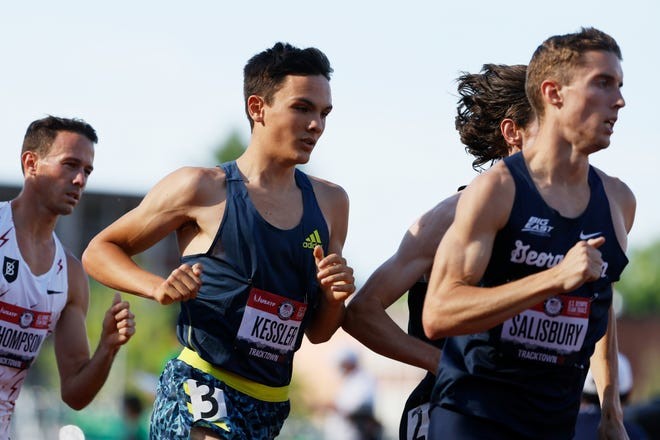
“The 3:34 was the turning point for all of this,” he said. “I’m in a position now that I don’t know that I will be in later, so I’m jumping on the opportunity that I have now and riding my momentum forward.” Kessler said he talked the decision over with multiple people from his family and team, and they all told him that going pro was the right call.
“It’s a bummer to miss out on the college [and] NCAA experience, but the positives outweigh the negatives,” he said. “Now I’m in a good position. My name is hot and I have a really good setup here running-wise and this gives me the ability to stay with my support system.”
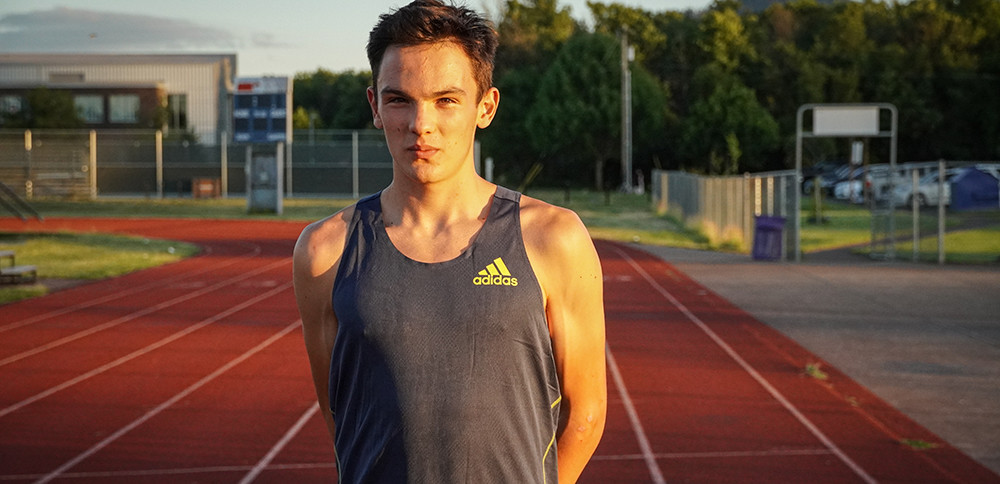
When asked about the prospect of turning pro in an interview with the Wall Street Journal, which occurred before his decision to sign with Adidas, Kessler said, “the benefits of going pro would have to outweigh missing the experience of going to college.” While he will be missing out on the NCAA experience, he is still going to attend NAU and live with members of the school track team.
Kessler currently trains in Ann Arbor with former University of Michigan coach Ron Warhurst in a crew with two-time Olympic medallist Nick Willis and other high-profile athletes. Kessler will continue to work with Warhurst as a pro, and he will return to Ann Arbor in the spring and summer when he’s not at school.
Kessler has had a year of many firsts, and he has another coming up on Thursday evening, when he will race the 1,500m at the U.S. Olympic Trials in Eugene, Ore. He qualified for the trials with his run in Portland last month, a result that gives him the fifth-best seed time in the entire field. The first round of the men’s 1,500m kicks off at 6 p.m. PT.
by Ben Snider-McGrath
Login to leave a comment
Introducing the Country’s Fastest High Schooler
Hobbs Kessler is taking the running world by storm
Last February, Hobbs Kessler, a 17-year-old senior from Michigan who has committed to run for the University of Northern Arizona next fall, set a new high school record for the indoor mile. His time of 3:57.66 made him only the twelfth American high schooler to break the four-minute barrier since Jim Ryun first did it in 1964. The feat was all the more notable considering that Kessler’s mile PB coming into the race was a comparatively modest 4:08.4, which he ran last summer. As Track and Field News noted, Kessler’s record had come “seemingly out of nowhere.”
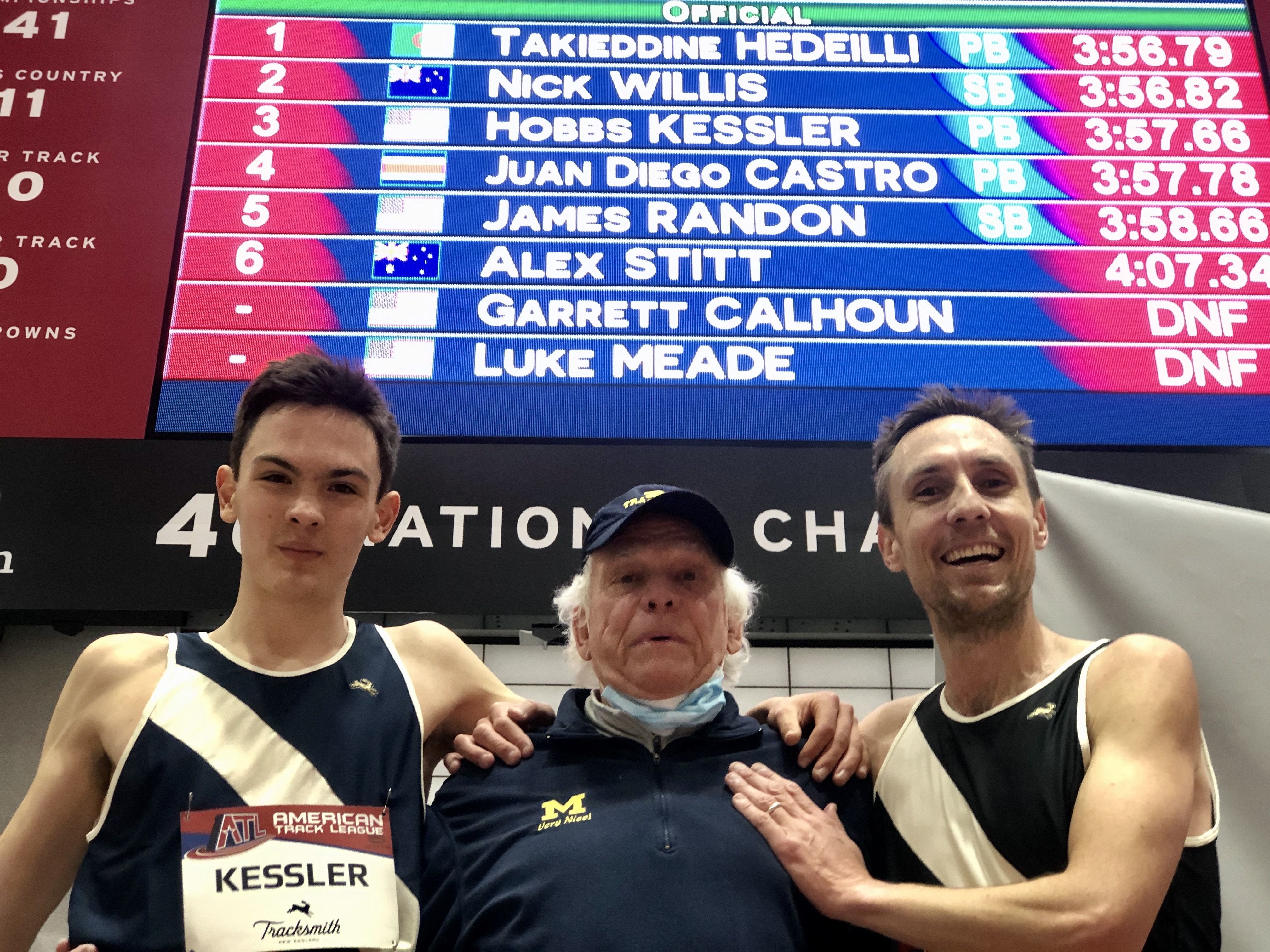
One explanation for Kessler’s sudden arrival into the upper ranks of American middle-distance running is that the pandemic has caused a number of rising stars to train in relative obscurity, with far fewer official meets to document the gradual progression of their talent. (Apparently, Kessler’s 4:08 mile last year was set in a time trial.) No wonder, then, that after his record-breaking run in February, the narrative around Kessler quickly morphed from Who is this guy? to What else is he capable of?
At last weekend’s Portland Track Festival, we found out. In the men’s 1,500-meters, Kessler, now 18, ran 3:34.36 to break Alan Webb’s 20-year-old high school record in the “metric mile” by almost four seconds—an eternity in such a short race. What’s more, Kessler’s time was also quicker than the men’s collegiate 1,500-meter record (3:34.68) and faster than the current Olympic standard (3:35.00). The guy few people had heard of six months ago was suddenly on the shortlist for the greatest U.S. high school runner, ever.
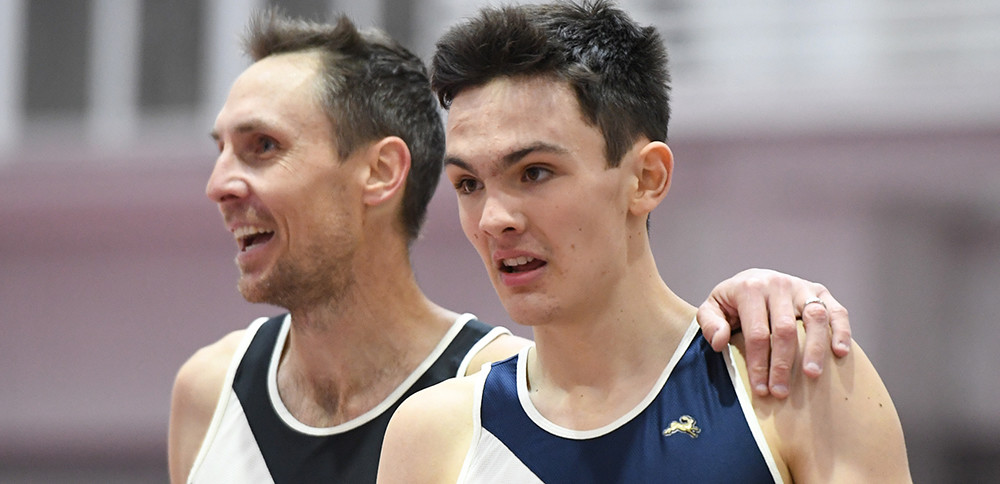
Until recently, track and field wasn’t even Kessler’s primary focus. In 2019, he represented the United States at the IFSC Climbing World Youth Championships. I caught up with Kessler to chat about the miraculous evolution of his young running career, choosing track over climbing, and his plans for the future.
OUTSIDE: Last summer, you cracked 4:10 in the mile for the first time. Less than a year later, you’ve run a 1,500 that converts to a 3:51. Are you shocked by how quickly you’ve progressed in such a short time? Can you still savor the moment?
KESSLER: In early 2020, I just wanted to run 4:13, indoors, in the mile. And then it kind of snowballed from there. I’ve gotten used to shifting my mindset on how I view myself as a runner. As I keep upping it, I always think, “OK, this is the last time,” but it hasn’t been so far. So, it’s been a little crazy in that regard, but I’m really enjoying it. I feel like I’ve been able to adapt my mindset really quickly—a lot faster than my folks. I think they’re still stuck six months back, which is pretty funny.
By “shift in mindset,” I’m guessing you mean a shift in expectations that you have for yourself. Are you worried that you might not be able to live up to your own standards, considering how quickly you’ve progressed?
I guess it can be a double-edged sword. In the winter, before I broke four for the first time, the 60-second-per-lap pace was everything, so that’s what we did all our workouts at. Now that I’m more fit, 57 is the new 60. But it’s all about not viewing it as fast. Because if I thought of 4:10 as fast, then I’d probably be running 4:10. So, you can control some of it with your mind. As far as not living up to expectations, I know that at some point I’m going to take a hit and not be running as well. But this season, I’ve been taking everything in stride and good things have been happening. I’ve never worried that I wasn’t going to run well.
There’s a theory that the bizarre circumstances of the pandemic might have helped some athletes nurture their talent by clearing their racing schedule. Is there any sense in which the events of last year changed your approach to training and racing?
As far as training goes, I would say the pandemic allowed me to just take a block from March 2020 to August to just get stronger. When the season got shut down, my dad switched me over to doing tempos on Tuesdays and hills on Fridays. But I was doing a lot of really fast strides because I wanted to develop my speed. Trying to work on my form. I’m a fairly fresh runner and haven’t been at it that long, so my running form is still very malleable. I didn’t have a race to worry about, so I just ran two big workouts a week and a big long run. I think people are realizing that racing less and training more can yield faster times. I’ve probably only gone all-out five times this year—but when I do decide to go all-out, I put a lot of emphasis on not wasting the opportunity.
I know that you are coached by your father, but also by Ron Warhurst—a legend in the coaching world, who is credited with “inventing” one of the sport’s most famous workouts. Do you have a favorite session that you like to do—perhaps something from Warhurst’s catalog of torture?
Both Ron and my dad have a lot of input in my training, but I’m more on Ron’s program now. I would say that my favorite workout of Ron’s has to be “Michigan,” because it’s his signature thing and you hit pretty much every pace and it can also be adjusted to wherever you’re at.
You’ve qualified for the Olympic Trials in the 1,500 as a high schooler. That’s nuts. But you’re also in a good spot in which there’s no pressure and where, presumably, you can just go and enjoy the experience. How do you plan to approach the Trials and do you have any other running goals for the summer?
After I broke four minutes in the mile, getting to the Trials was really the big goal. So I’m very excited about that race. Originally, I was just viewing it as a great experience where I could learn a lot so that, in three years, I might be in a position to compete for a spot on the team. But now that I’m one of the few people with the Olympic standard, my mindset has changed a bit. My thinking is that, if I’m there, I might as well have a run at the team. It’s a win-win because if I make the Olympic team that would be awesome, but if I don’t, I’m only 18 and will have a lot more attempts at it. I feel like I’m in a very cool spot where there’s no pressure, but I might as well give it a go.
You have an impressive climbing background, but it seems like you’ve decided to prioritize running for now. Was that decision based primarily on the fact that running is where you have the most talent, or was it something else?
I’m definitely prioritizing running, but I wouldn’t say it’s a conscious decision. That’s just the sport that I’ve drifted more towards in the past year or two and it’s what I’m more excited about. It’s not that I decided that I could be more successful at it, so much as that I’ve drifted towards it throughout high school.
Do you feel like the two sports complement each other in some way?
I think climbing really helps running, but running doesn’t really help climbing.
How so?
Well, the big carryover from both—and this does go either way—is that the mental stuff is the same. Race nerves in running and redpoint jitters in climbing. So there it’s the same stuff. In competitive climbing, I had to develop skills to deal with it, which translated directly to my running. But I think running destroys my coordination a little bit for climbing, so it’s hard to do both at the same time. I tried to be really good at both at the same time, but it just wasn’t possible because they started fighting each other a little bit. So I decided to let go of trying to be really good at climbing and to just do it because I enjoy the act of it.
You’ve now run a time that is faster than the NCAA 1,500-meter record. Unsurprisingly, this has fueled speculation that you might decide to go pro and skip college-level racing altogether. Do you think that early success can obscure the fact that running talent still needs to develop gradually?
When I was talking to colleges that was one of the biggest criteria I had. I wanted to make sure they developed me and weren’t just trying to get as much out of me while I was in school. So I’ve kind of had that view. Running aside, if I were to go pro, it would have to create a situation that would be worth missing out on the experience of being in college and being on a team. And I really want that experience. I’m not ready to be done being on a cross-country team. So going pro would have to outweigh that by a significant amount. Everything seems really immediate and important right now, but I have confidence it will even out. Whatever decision I make, I have confidence in the people who have been guiding me so far.
by Outside Online
Login to leave a comment
Hobbs Kessler Breaks Alan Webb’s Legendary High School 1500m Record
Runs 3:34.36 to Get Under Olympic Qualifying Standard
In one of the most incredible runs ever by an American high schooler, 18-year-old Hobbs Kessler ran a 3:34.36 1,500m at the Portland Track Festival tonight to obliterate the US high school record. The previous record, 3:38.26, was set by Alan Webb as a 1500 split en route to his legendary 3:53.43 high school mile record at the 2001 Prefontaine Classic.
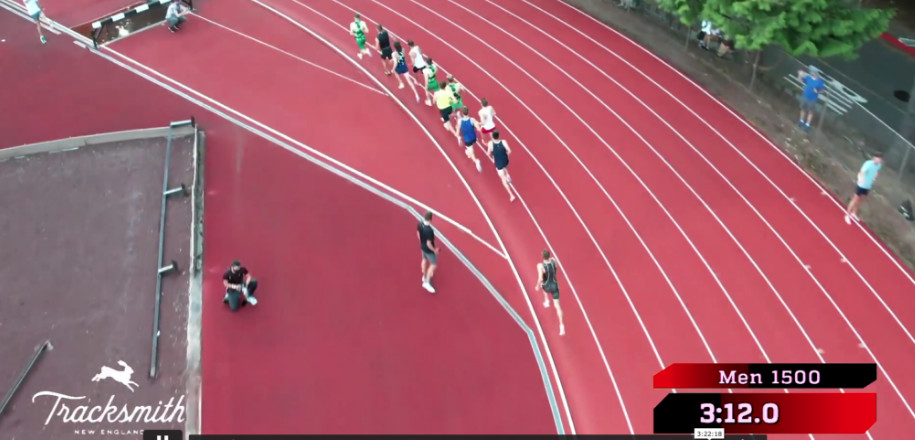
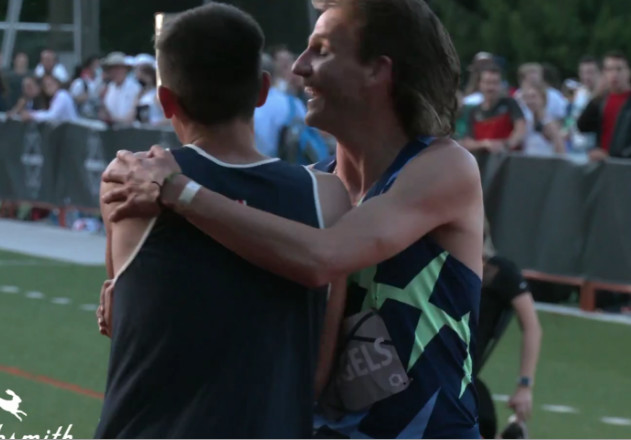
Webb’s 3:53.43 has gone unchallenged for two decades, but according to World Athletics’ scoring tables, Kessler’s 1500 tonight was the superior performance; converting to 3:51.34 for the mile (Webb’s 3:53.43 mile converts to 3:36.30 for 1500). Kessler’s time is also faster than Jim Ryun‘s US U20 1,500 record of 3:36.1 which had stood since 1966.
Kessler, who was last in the lead pack of ten with 200m to go, moved up well the final 100 meters, and threw up his hands just before the finish line as he saw the clock and finished 5th in a race won by reigning US champ Craig Engels in a personal best of 3:33.64. Engels, the 2019 US indoor/outdoor champion and a World Championship finalist, entered tonight with a pb of 3:34.04 — barely faster than what Kessler ran.
Kessler, a senior at Community High School in Ann Arbor, Mich., was already a high school record holder after running 3:57.66 in February to take down the indoor mile record. Now he is, quite simply, one of the best milers in the United States, regardless of age. His time was the third-best by an American in 2021 — only the winner Engels and fourth-placer Henry Wynne (3:34.08) have run faster this year.
How incredible was Kessler’s run? He didn’t just break the US high school record by almost four seconds; he also ran faster than the collegiate record of 3:34.68 set by Notre Dame’s Yared Nuguse two weeks ago. He also hit the Olympic standard of 3:35.00 — one of just seven Americans to have done so during the qualification period.
Kessler’s run was so much faster than any other high schooler has run for 1500 that it is hard to even make comparisons. Webb’s 3:53.43 at Prefontaine, which celebrated its 20th anniversary on Thursday, is the obvious one. Just like Webb, Kessler finished 5th in a field of pros, and just like Webb, Kessler was mowing them down over the final 100 meters.
As impressive as Kessler’s run was tonight, it was not the greatest ever performance by an American U20 athlete. That remains Jim Ryun’s 3:51.3 mile in July 1966 — a world record at the time that would stand for eight years. Ryun was just 19 years old at the time of that race, which came after his freshman year of college.
Kessler is a high school senior. His sometimes training partner, Nick Willis, an Olympic 1500m silver and bronze medallist, was in this race and tried to put it in perspective on the broadcast afterwards, “I became a spectator to the greatest performance ever by a high school miler,” said Willis, noting he himself went out at the pace prescribed for the rabbits for 800, yet was in last place. “It’s like Jim Ryun reincarnated again…He’s such a rookie in terms of running…. He’s so raw.”
by Let’s Run
Login to leave a comment
16-Year-Old Rheinhardt Harrison Trying To Become The Youngest Runner In History To Break The 4-Minute Barrier At The Atlanta Track Club Classic
An attempt to become the youngest runner in history to break the four-minute mile barrier headlines Saturday night's Atlanta Track Club Classic. Start lists for the middle distance-focused meet, which will be held at an undisclosed high school facility in Atlanta, were released today.
Rheinhardt Harrison is already the fastest 16-year-old in American history. Last month, the Florida high school junior ran 4:01.34 at the Music City Distance Carnival in Nashville. On Saturday, he will attempt to become just the 12th American high school runner to break four minutes in the mile and the first junior to do so since Jim Ryun's historic run in 1964. Harrison would also become the youngest person ever to run under four- minutes at 16 years, 6 months and 28 days old. Jakob Ingebrigtsen of Norway was 16 years, 8 months and 18 days old when he broke four-minutes at the Prefontaine Classic in 2017.
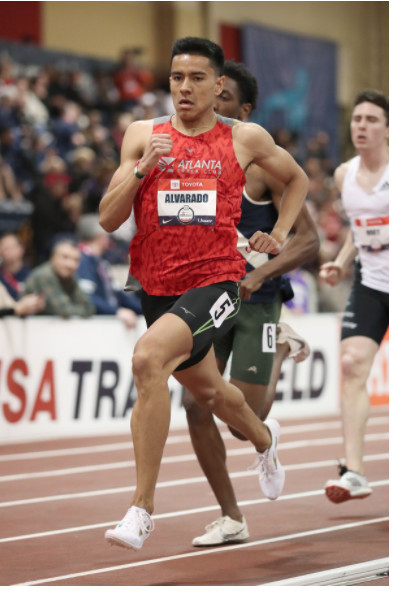
Harrison will be joined on the start line by former Florida State standout Kasey Knevelbaard (3:58.08). Multiple pacemakers have been assigned to the race with a goal pace of 1:59 through 800m for Harrison.
The District Track Club's Edose Ibadin leads the men's 800m having run a season's best of 1:44.81 last month in Washington D.C. Teammate Alex Amankwah (1:44.80) and Atlanta Track Club's Abraham Alvarado (1:46.62) will challenge Ibadin for the victory.
The women's 800 includes two women on the cusp of breaking two minutes. New Balance's Hannah Segrave (2:00.18) and The District Track Club's Jazmine Fray (2:01.18) lead a field that will also include high school national record holder Sammy Watson (Adidas) and former NCAA runner-up Allie Wilson (Atlanta Track Club).
The Atlanta Track Club Classic will kick off with a series of masters races including a men's and women's 100m and a men's mile. Elite races will be streamed on Atlanta Track Club's Instagram account (@atlantatrackclub) beginning with the men's 800m at 7:45 p.m. EST.
Atlanta Track Club will follow strict COVID-19 safety protocols as required by USA Track & Field's sanctioning requirements to ensure the safety of the athletes, coaches and staff. All athletes must submit two negative COVID-19 tests within seven days of the event. Wellness checks will be administered on site. No spectators will be permitted inside the venue.
Login to leave a comment
1972 Olympic silver medalist Ben Jipcho, a pioneering Kenyan middle distance runner, died on Friday
World Athletics is deeply saddened by the news that Ben Jipcho, a pioneering Kenyan middle distance runner, died on Friday (24). Jipcho, the 1972 Olympic silver medallist in the 3000m steeplechase and former world record holder in the event, was 77.
Jipcho died of multiple organ failur at the Fountain Hospital in Eldoret where he had been hospitalised since Wednesday (23).
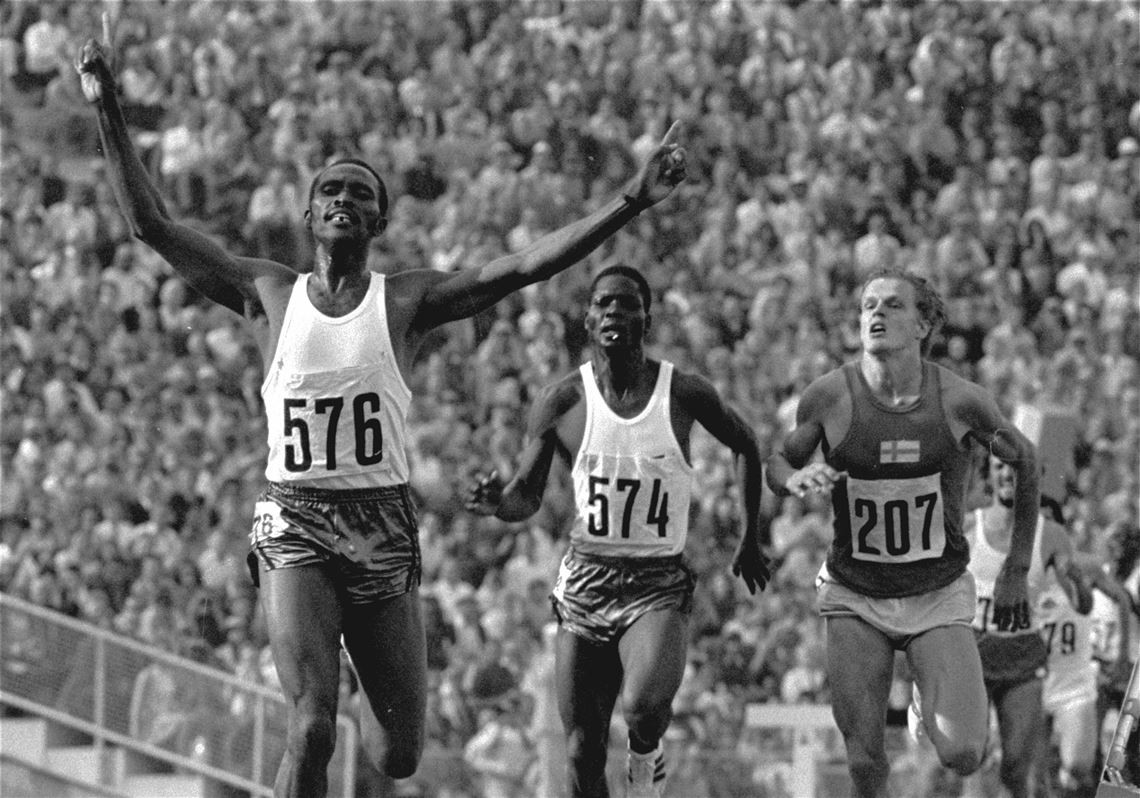
"We are saddened by the loss of Jipcho, a pioneer of athletics in Kenya. My heartfelt condolences to his family and Kenyans at large," said Paul Tergat, President of the National Olympic Committee of Kenya.
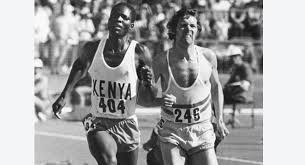
Jipcho, who began his running career in the mid 1960s, rose to prominence in the 1968 Olympic 1500m final in Mexico City where he sacrificed his own ambitions to figure in the medal battle by acting as a pacesetter for Kipchoge Keino, who went on to win the title over Jim Ryun. Jipcho set out on a world record pace, covering the first lap in 56 seconds and bringing Keino through 800m in 1:55.3. Keino won in 3:34.91, an astounding performance given Mexico City's high altitude, an Olympic record that stood for 16 years while Jipcho eventually crossed the line tenth.
He returned to the Olympic stage four years later, and again in the same race with Keino, this time the 3000m steeplechase. Keino won again in Olympic record time by Jipcho caught Finn Tapio Kantanen at the line to take silver by a scant 0.02 in 8:24.62.
His finest championship performances came at the 1974 Commonwealth Games in Christchurch, New Zealand, where he raced race to victory in the 5000m and 3000m steeplechase and taking bronze in the 1500m.
He also won the 5000m title at the 1973 All-Arica Games and silver in the steeplechase at the 1970 Commonwealth Games.
Jipcho broke the world record in the 3000m steeplechase twice over the course of eight days in 1973, first clocking 8:19.8 on 19 June then smashing that performance with an 8:14.0 run on 27 June, both times in Helsinki.
Jipcho was later among the key stars of the International Track Association (ITA), a short-lived professional tour in the United States in the early 1970s.
In a post on the government's Facebook page, Kenyan President Uhuru Kenyatta eulogised Kipcho "as a pioneer athlete who helped cement Kenya's profile on the international stage as a top athletics nation".
Wesley Korir, the 2012 Boston Marathon champion and a former Kenyan MP, told The Standard, "Jipcho gave us a foundation which we used to build our running career. We have lost a pillar that will be hard to replace."
by World Athletics
Login to leave a comment
Mile runner Jim Ryun Receives the Medal of Freedom at the White House
Jim Ryun, the first U.S. high schooler to break four minutes in the mile and an Olympic silver medalist, receives the Presidential Medal of Freedom in the Oval Office, the nation’s highest civilian honor, on Friday.
President Donald Trump on Friday presented one of the nation’s highest civilian honors to Jim Ryun, a former Republican congressman and the first U.S. high schooler to break the 4-minute barrier in running the mile.
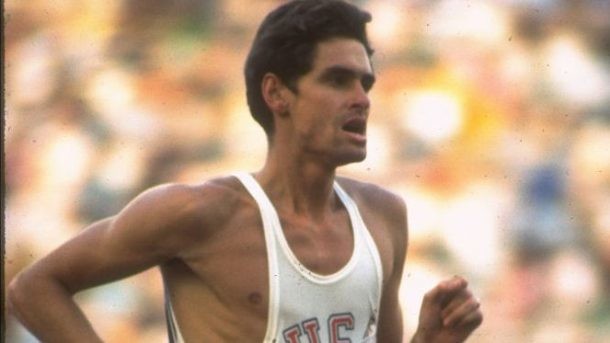
Ryun was the 1968 Olympic silver medalist in the 1,500-meter run and is a three-time Olympian. Trump presented him with the Presidential Medal of Freedom during a ceremony at the White House, calling him a “Legendary athlete and legendary runner."
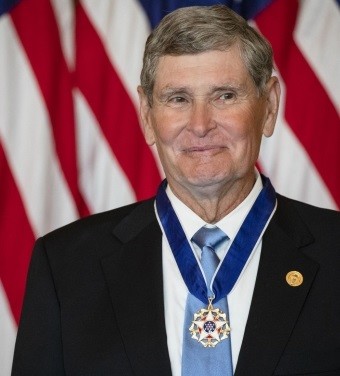
The Presidential Medal of Freedom is presented to those who make especially meritorious contributions to the nation.
He joins a long line of Olympians to receive the Presidential Medal of Freedom, including Jesse Owens, Muhammad Ali and Pat Summitt.
In a news release Tuesday, the White House said it is awarded “to individuals who have made especially meritorious contributions to the security or national interests of the United States, to world peace, or to cultural or other significant public or private endeavors.”
“I’m very humble that I was even considered,” Ryun said by phone on Monday. “One of the things that’s really special about it, too, is that I’m getting it while I’m alive. Sometimes these are awarded after you’re dead.”
Ryun, 73, followed his running career, which included an eight-year span as mile world-record holder, by serving two terms as a U.S. Congressman for Kansas from 1996-2007. Last Friday marked the 54th anniversary of his mile world record performance of 3:51.3 at age 19.
Ryun competed in the Olympic 1500m in 1964 (at age 17), 1968 and 1972. He reached the final in 1968 and earned silver behind Kenyan Kip Keino. He remains the 11th-fastest miler in U.S. history and the oldest in the top 75.
Ryun reflected Monday about failing to make any of his junior high school’s sports teams. He was even cut from his church baseball squad. But within two years of starting cross-country in high school, he broke the four-minute barrier and made the Olympics.
When LeBron James was getting national TV coverage as a high school phenom, ESPN published a list of the greatest prep athletes in history. James was No. 3. Tiger Woods was No. 2. Ryun was No. 1.
Ryun said he still runs two or three days a week.
“But you can’t really call it running anymore. It’s so slow,” he said. “It’s certainly not very fast. It used to be four-minute miles. I’m not even sure I could do a four-minute half-mile now.”
by OlympicTalk
Login to leave a comment
Leo Daschbach Ran a sub four minute mile Saturday night to join the HS list of just 11 who have done it
It took just .46 seconds for Leo Daschbach to reaffirm his status as the greatest high school boys distance runner in Arizona history on Saturday night May 24.
The Gilbert Highland senior, who is also The Republic's reigning Boys Track and Field and Boys Cross Country Runner of the Year, won the last race of his legendary high school running career at the Quarantine Clasico at Oak Ridge High School (El Dorado Hills, Calif.), finishing under the coveted 4-minute mark on a 3:59:54 time.
That puts him in ninth place in the nation's history among the 11 boys who broke the sub-4 mile and the first to reach the mark since 2017. Daschbach is the fourth person reach that time alongside Jim Ryun, Lukas Verzbicas and Michael Slagowski in a high school-only race, according to LetsRun.
“I’m really not surprised because this kid is a one-percenter. I’ve been in this sport 50 years and I’ve never seen anything like this," Highland boys track and field coach David Montgomery said.
The achievement makes Daschbach the best miler in state history. In addition, Daschbach got his second all-time national mark within a year after earned the second-best all-time mark in the 5K at the Desert Twilight cross country meet in September.
On the final 200 meters of the mile race, Daschbach stormed from behind and went from the fourth to first place runner in his six-person heat and ran a stunning final lap. Knowing his clocked time at the 3:02.74 minute mark in the penultimate lap, he needed to catch up on 57.25.
"I was pretty much just focused on the moment and the race, making the right moves and when to surge," Daschbach said via text message. "I didn’t even know how close I was until I came across 100 meters left and saw 3:46 on the clock."
The Washington commit increasingly pulled away from his competition down the home stretch, leaving Valor Christian (Highlands Ranch, Col.) senior runner Cole Sprout to end in second place. Sprout just missed the sub-4 at 4:02.42.
Similar to the Quarantine Clasico, Sprout also came in second behind Daschbach at the Desert Twilight by a mere 2 seconds.
Daschbach didn't believe that he could hit the sub-4. However, Montgomery said that Daschbach gained a new confidence over the past few weeks in his workouts and that this rare feat was within his reach.
"He (recently) ran another mile at 4:07 and from his time trial, he just didn’t feel it that day. He’s really been crushing workouts before this thing got going with these six kids doing this (Quarantine Clasico) in California," Montgomery said. "His leg speed is just phenomenal. That last lap, you can’t teach that. He’s very competitive and he doesn’t really care about records. He runs to win.
"He told me this a couple years ago: 'Coach, if you put me in a race, I’m running to win. If I win, great, and if I don’t, that’s OK, too.'”
Login to leave a comment
University of Virginia President Jim Ryan is running the Anthem Richmond Marathon on Saturday in support of Madison House
Login to leave a comment
Kip Keinoa grandson Julius Keter won Chip Gaines New Marathon and $15,000
Julius Keter comes by running naturally since his grandfather is Kip Keino, the legendary Kenyan who won the 1,500 meters in a famous race against Jim Ryun of the United States in the 1968 Summer Olympics. Keter is also a fan of “Fixer Upper,” so running in the inaugural Silo District Marathon was perfect for him Sunday morning.
Running strong from start to finish, Keter won the marathon against a talented international field for the $15,000 first-place prize. He clocked 2:16:26.
The event drew 6,000 entrants with total prize money of $88,000, a big purse which attracted runners from all 50 states and seven countries. While 3,150 competitors entered the 5-kilometer race and 2,150 runners signed up for the half-marathon, the marathon featured 750 entrants that included some top-shelf talent from across the world. “Fixer Upper’s” Chip Gaines also ran his first marathon, which held great appeal to an estimated crowd of 18,000 that crammed into the Silos area beginning at 6 a.m.
Gaines stood on a table wearing a tool belt with wife Joanna at the start of the race. The women’s marathon winner was Shewarge Alene Amare who has a goal to compete in the 2020 Olympics for Ethiopia. Like Keter, she brought home $15,000 in prize money after coming in at two hours and 38 minutes. “I’m so proud to be in the first marathon here and I’m so happy for the victory,” Amare said. “I entered the race two weeks ago. I’ll do some races and then go back to Ethiopia.”
Login to leave a comment
The first High School Runner to run a sub four minute mile in 1964, Jim Ryun is 71 today
by Gary Cohen
Login to leave a comment
Many of the top runners in the world come from Kenya and here is a good answer why
Kenya is known around the world as the home of champions and we wanted to know why. One tribe in Kenya that stands out more than others is the Kalenjins.
At the 1968 Olympics Kalenjin runner Kipchoge Keino defeated world-record holder Jim Ryun.
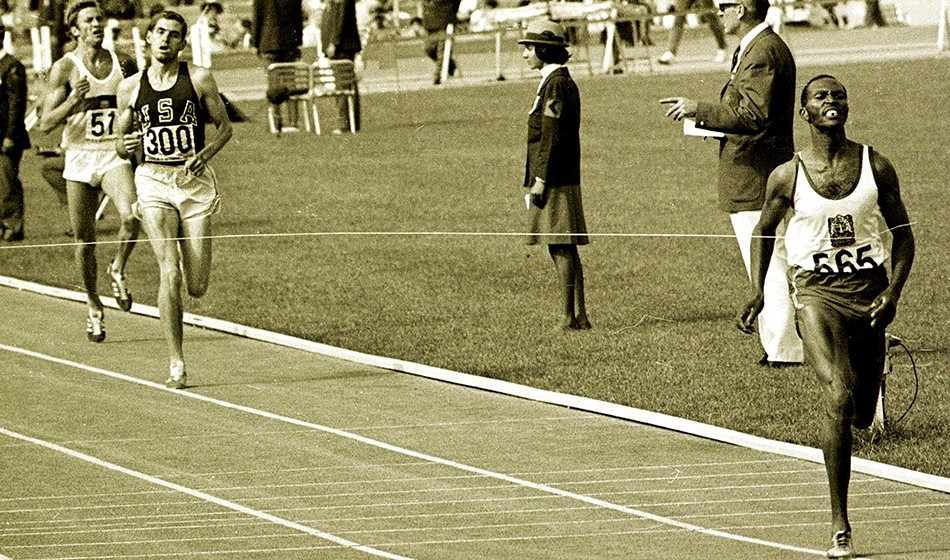
That day Keino not only won gold, but he also ushered in an era of Kenyan dominance. Since then a considerable number of the races are won by Kenyans and many world records are held by Kenyans. Many of these runners are of the Kalenjin tribe.
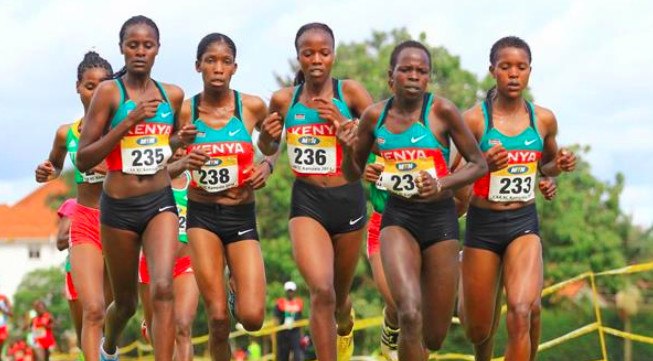
The feats have just bafflled the world. David Epstein a renown sports editor who authored a book called “The Sports Gene'” noted that many world-class runners in Kenya come from the tribe of Kalenjins. In his book, he explores possible genetic factors that might be the reason behind this.
He notes that Kalenjins have thin ankles and calves which makes their legs resemble a pendulum and eases their movement. According to his explanation, the more weight you have farther away from your center of gravity, the more difficult it is to swing.
The vice versa applies to Kalenjins. Some studies have also discovered that Kenyans, in general, have less mass for their height, longer legs, shorter torsos and more slender limbs. These physical traits can be viewed as relatively “streamlined” and improve efficiency while running.
Lastly, there is a controversial cultural argument that Kalenjins become great runners because they ran several miles to and from school barefoot on a daily basis.
Login to leave a comment
Jim Ryun and family mourns the passing of this giant of a man - Dr Roger Bannister
Login to leave a comment





